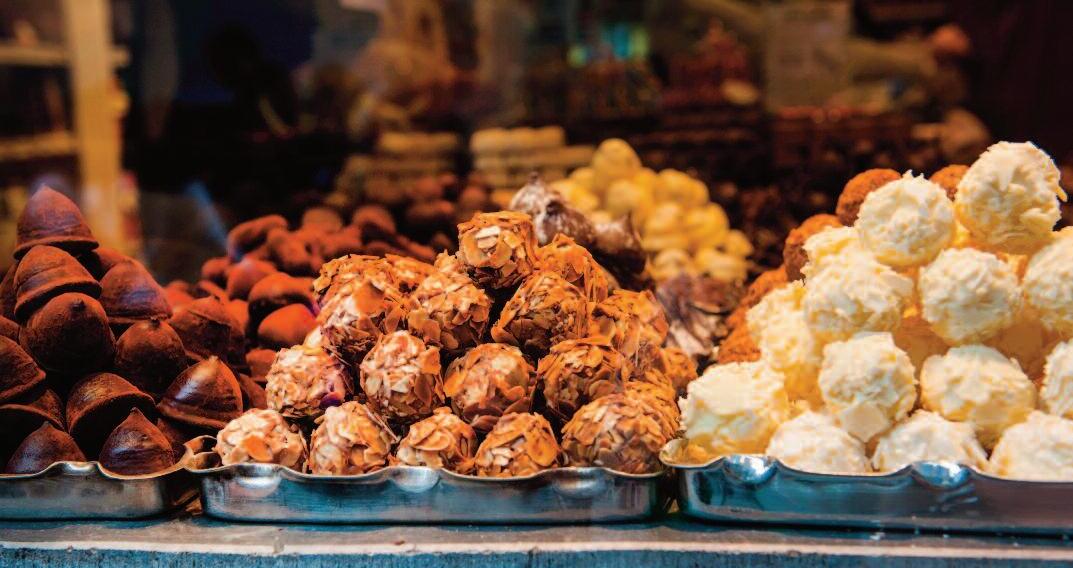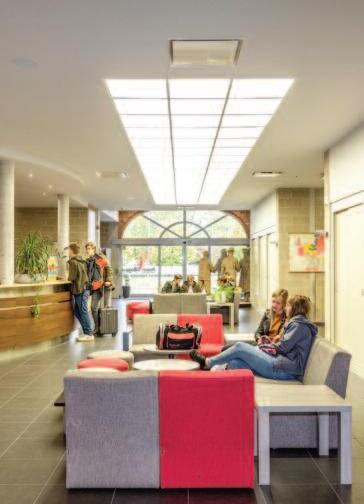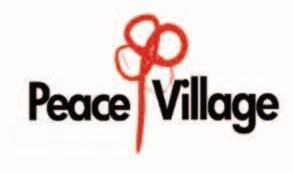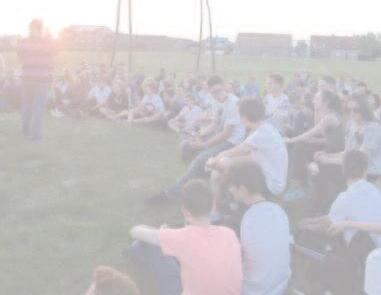Flander s For Groups

























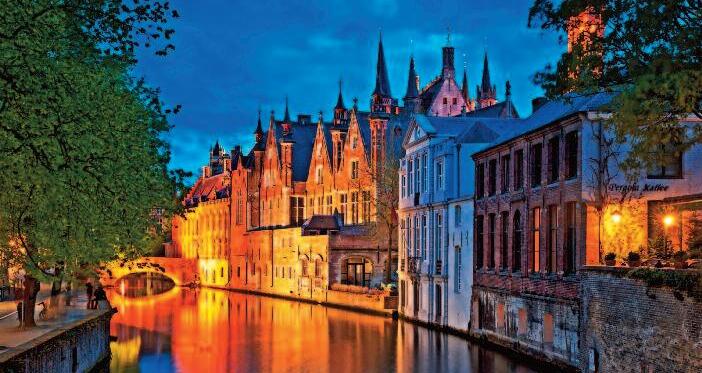
Flanders is not a place Not really It’s a mood, a tone, a subplot in the middle of a continent’s unfinished novel. It's the footnote that turns out to be the point, the aside that becomes the headline You don’t go to Flanders the way you go to Paris or Prague. You findyourself there –halfway between history and lunch –and realise that, without ever meaning to, you ’ ve stepped into a story that started long before you were born and will carry on long aer you ’ ve gone back to your spreadsheets.
is is a land that has seen too much to shout about itself e fields are quiet not because there ’ s nothing to say, but because so much has already been said, and bled, and buried. e Great War rolled through here like a thunderclap, and the silence it le behind is neither empty nor forgetful. In towns with names like Ypres and Passchendaele words that sound like sobs swallowed mid-sentence the past still whispers beneathyour feet ere are museums, of course, and monuments, but the real memorial is the soil, the stillness, the way the light
falls in the late aernoon like an elegy
But Flanders is not just the world’s most eloquent cemetery. It is, at the same time, a cathedral of culture, a gallery with no roof e Flemish Masters Rubens, Van Eyck, Bruegel –painted not just with oils but with a kind of muscular faith in observation. ey didn’t flatter the world; they revealed it ey gave us peasants and angels, drunks and saints, heaven and muck. ey proved that realism could be miraculous.
en there are the castles some crumbling romantically into ivy, others preening with fairy-tale arrogance – and the gardens, manicured to within an inch of their lives, then let loose in a mad dash of tulips and topiary You half expect a unicorn to peer at you over a hedge.

e food is criminally under-celebrated is is a land where chips are a religion, beer is a sacrament, and chocolate is a philosophicalposition. Flemish cuisine is not delicate it’s baroque.

It’s braised and battered, caramelised and creamed, boozy and brave.
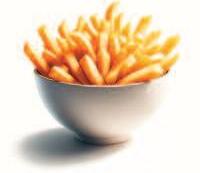
Mussels sit smugly in steaming bowls beside fries so perfect they might be illegal in France
And then there are the cyclists those Lycra-cladpilgrims who hurl themselves up cobbled hills with the grim determination of medieval monks seeking redemption through pain. e Flemish landscape, flat as a pancake one minute, hellishly lumpy the next, is a cyclist’s purgatory and paradise
Flanders is a patchwork of regions, each with its own accent, its own beer, its own quietly stubborn identity. ere ’ s Antwerp, with its swagger and style; Ghent, like the cool sibling who reads philosophy and listens to vinyl; Bruges, a chocolate-box dream with a darkpast; and the coast, where wind, sea, and waffle stands conspire to blow the cobwebs out ofyour soul








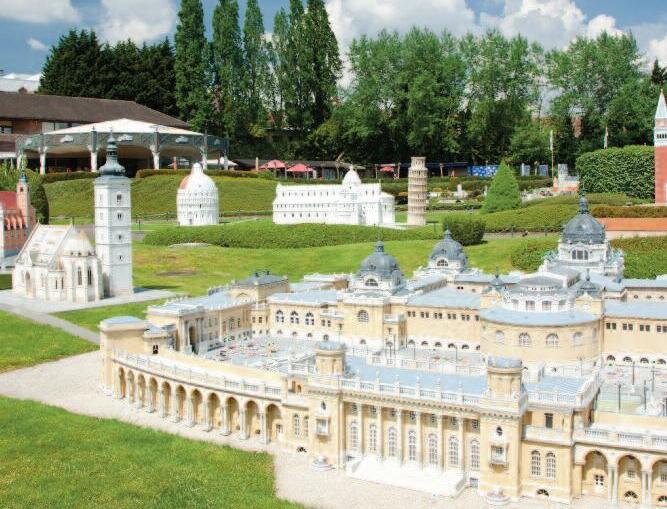
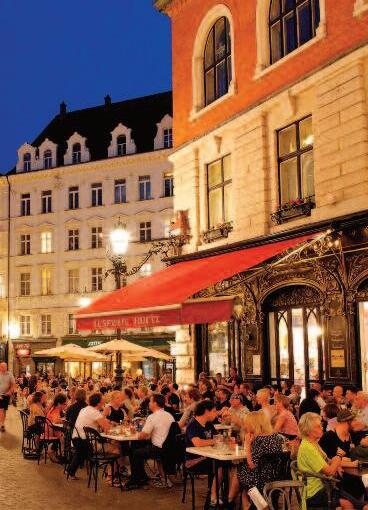
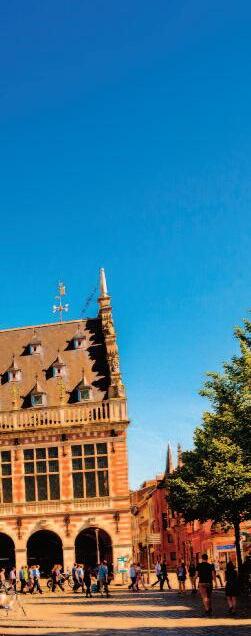
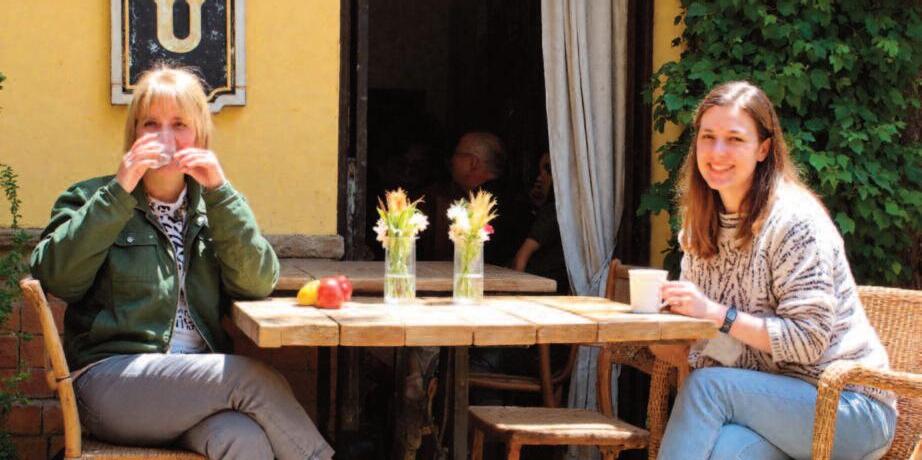
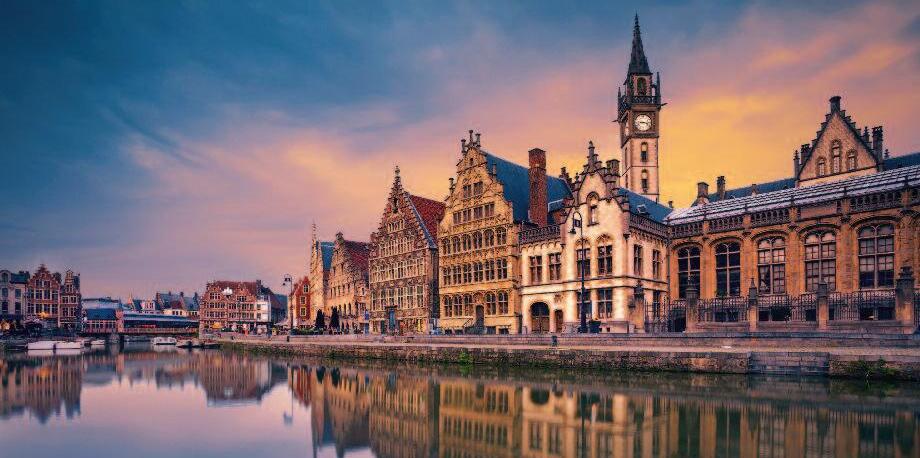
ere’s a quiet moment at the start of ever y group trip the coats zipped, the seats taken, the clipboard held alo and someone always asks : “ Where are we off to, then?” at’s the bit where confidence matters. Where being well-prepared turns into being wellreg arded. And that’s why more and more org anisers are clicking their way to www visitflanders com
is isn’t just another tourism website. It’s a g ateway. A neatly curated trove of coachfriendly cathedrals, cobbled backstreets, riverfront cafés, and chocolate shops that lean into the divine It understands that group travel isn’t about ticking boxes It’s about g iving people moments the y’ll still be talking about on the return ferr y preferably over dut y-free pralines
Want heritag e ? You’ll find it From the sombre grace of Ypres and the Last Post Ceremony at the Menin Gate to the proud bell towers of Brug es and Ghent. From medieval tapestries to war memorials and world-class g alleries, Flanders wears its histor y with pride. Need a foodie detour ? ere’s a breadcrumb trail to abbe y beers, stoof vlees, and fries twice-fried by monks
( probably). And if it’s art you ’ re aer well, this is the land of Brueg el, Rubens, and the oddly loveable Ensor.
But the real brilliance of V isitFlanders.com lies not in the sig hts it lists, but in how it *thinks* It speaks the lang uag e of org anisers. It knows that while some travellers mig ht be spontaneous, the person holding the clipboard is not. So ever ything ’ s laid out clearly : sug g ested itineraries, group ticket info, accessibilit y tips, coach parking notes, restaurant recommendations, and insider updates that make you feel like a local It’s not shouting for attention It’s g uiding you g ently, like a wellinformed friend who’s already had the waffles and knows which museum café ser ves the best coffee
And it g oes be yond the obvious ere are thoug htful nods to lesser-known towns and hidden g ems, plus themed routes that help org anisers shape a trip not just as a destination, but as a stor y.
ink “Great War Remembrance,” “Cycling wit a Coach Base,” or “A Taste of Flanders” each one a readymade reason to return
ere’s even a dedicated Groups section, packed with downloadable brochures, practical toolkits, and sug g ested multi-day tours tha
take the pressure off planning . Whether you ’ re new to European trips or a seasoned tour leader, it’s all there just a click away
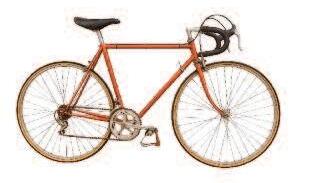
Most importantly, it’s reliable No outdated PDFs. No endless Goog ling . Just accurate, inspiring , welldesigned support for the people who carr y the plans and make the mag ic happen
So if you ' re plotting a trip that needs to impress from the first footstep to the final thankyou, make www visitflanders com your first stop It’s not just a website. It’s the beg inning of a stor y your group will want to tell ag ain
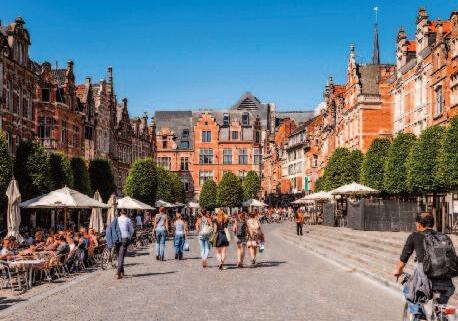

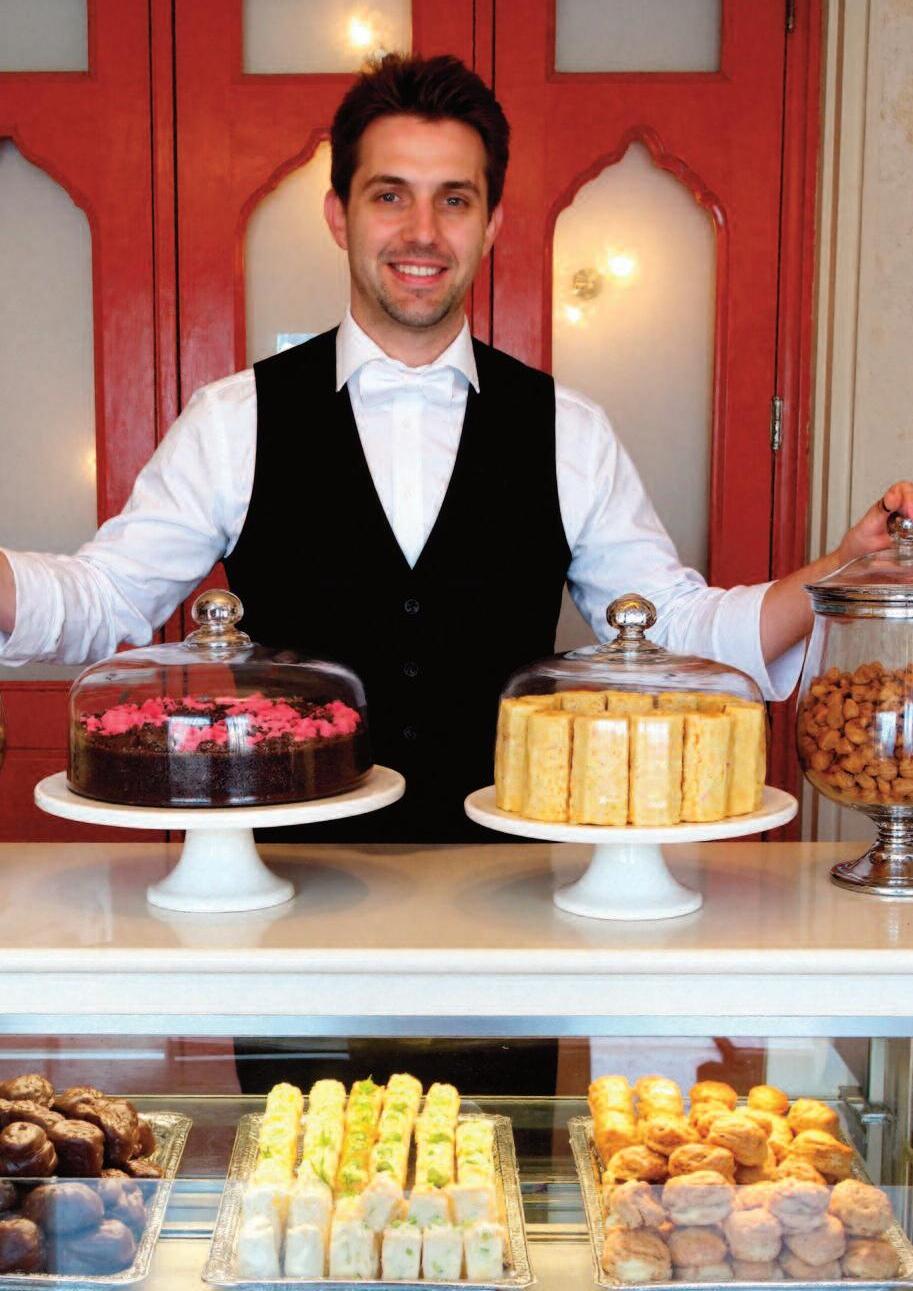
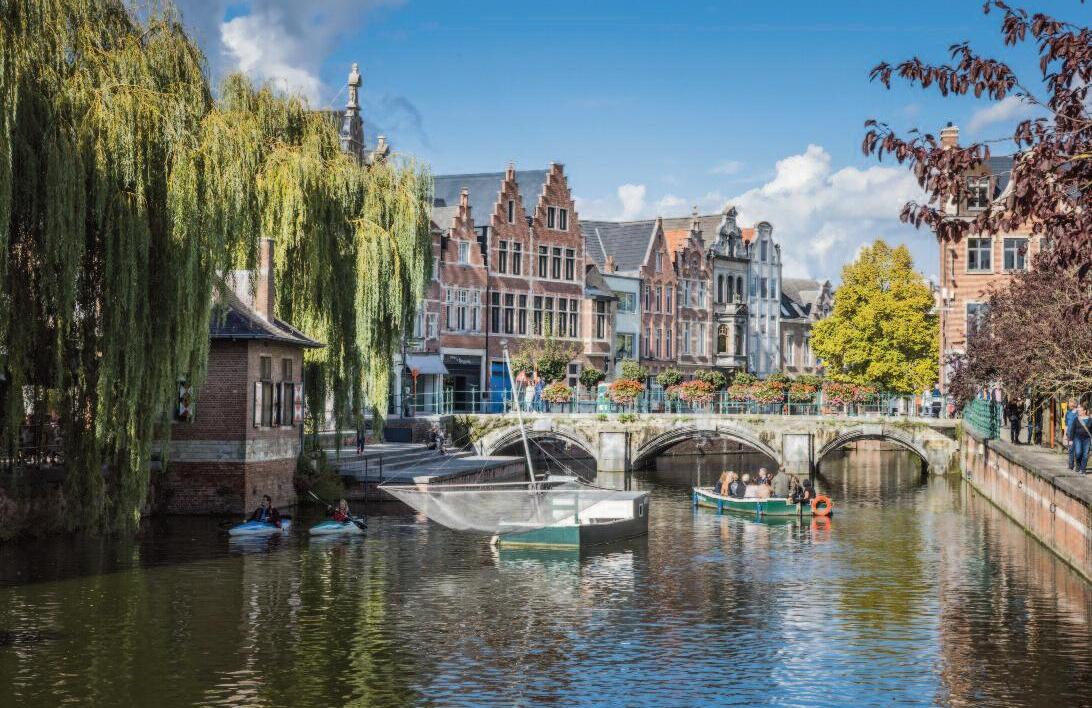
If Belgium were a novel, Lier would be one of those perfectly formed chapters you return to more than once. It is not a headline act. It does not try to compete with the bigger, brasher scenes of Brussels or Antwerp
Instead, it offers something quieter, something kinder. L ier does not announce itself
It beckons Tucked g ently between Antwerp, Brussels and Mechelen, L ier is the kind of place you visit for a day and wish you had booked the whole weekend. It is compact enoug h to wander without aim and layered enoug h to reward those who pay attention
With cobbled streets, canals that catch the lig ht just rig ht, and a skyline of spires and g ables that looks like it has been borrowed from a medieval manuscript, L ier is a place that remembers how to charm.e heart of the cit y
beats at a walking pace You can see most of what you need to see on foot and yet somehow you still feel like you are discovering something new with ever y turn.
e most famous landmark is the Zimmer Tower. What was once part of the old cit y walls now contains one of the most peculiar and beg uiling clocks you are ever likely to find. On its face are thirteen dials, each measuring a different kind of time. It does not just tell the hour It shows you the phases of the moon, the tides, and the progression of the zodiac.
ere is something rather humbling about standing before a clock that measures not just your minutes but the cosmos itself Inside the tower, the Zimmer Museum continues the theme, with displays that explore astronomy, timekeeping and the g enius of Louis Zimmer, a local watchmaker with a mind for the infinite.But L ier does not live in the past. It moves between centuries with ease
e UNESCO -listed beg uinag e is a case in point Step throug h its g ates and you are in a different world.

e beg uinag e is made up of eleven streets and dozens of tiny whitewashed houses, each with its own stor y and a sense of quiet that is almost sacred. Once home to relig ious women who lived in communit y without taking vows, today it is a peaceful quarter where the air seems to carr y memories. Some of the homes open their doors to visitors and inside you may see examples of L ier lace. is delicate handiwork, a kind of embroider y with thread and
air, is part of the cit y ’ s cultural fabric.
For a d ifferent view of the city, take to the water.
Traditional eel barg es cruise along the Nete river and provide a view of L ier that is both unusual and intimate From the deck, building s lean in to tell their stories. e skipper, never short of a tale or two, will fill in the rest. ere is something wonderful about seeing a cit y from the
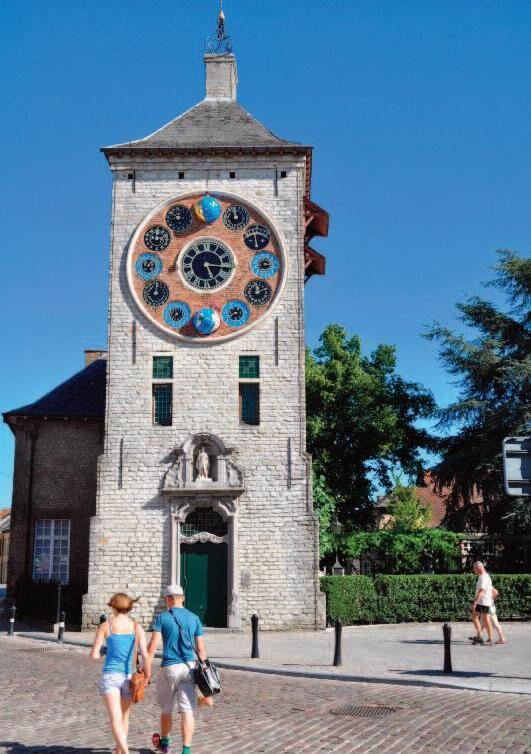
water. It soens ever ything .
e houses seem more at ease.
e pace slows even further And for a moment, time forg ets to tick .
Back on land, the interactive cit y museum offers another kind of journe y Here, you can meet the people of L ier, past and present. You can explore traditions and dialects, learn about the local artists, the odd leg end of the sheep’s heads, and the veneration of Saint Gummarus, the cit y ’ s patron
is is not a museum that stands behind g lass You are

encourag ed to poke, press and play your way throug h it. You are a g uest and a participant.And when the culture has been thoroug hly absorbed, you will want something sweet. Find a café, preferably one with a view of the water or the belfr y Order a cup of coffee and a L iers V laaike. is little pastr y, spiced with cinnamon and filled with a dark, treacly mixture, is a taste of the cit y itself Modest in appearance Memorable in effect
With energ y restored, there is still time to explore the shops L ier ’ s boutiques are small, independent, and wellcurated You will not find chains or crowds here. You will find linen dresses, local ceramics, handmade chocolates, and thing s you did not know you wanted until you saw them in the window
way to the old town hall. Inside is the V isit L ier tourist information office e staff are helpful in that ver y Belg ian way efficient but not rushed, friendly without being effusive. Pick up a map, ask about an exhibition or a walking route, or simply browse and let the cit y do the rest.
L ier is sometimes affectionately called “L ierke Plezierke,” a phrase that roug hly translates to “L ittle L ier, Full of Pleasure.” It is not a boast It is a truth ere is joy here Quiet joy e kind you don’t always notice until later, when you are somewhere else and thinking back on a day by the river, a clock with thirteen faces, a bite of pastr y, and a feeling you would quite like to feel ag ain
e
You arrive by coach, perhaps, and tumble out into the flat lig ht of the Flemish coast, past a line of flower boxes and a roadside café that still sells Orang ina in g lass bottles. It’s not grand It’s not Brug es It doesn’t want to be is is Adinkerke, a place more practical than prett y, with just enoug h old bricks and low skies to keep your imag ination working And here, tucked between the perfume shops and border-barg ain cig arette warehouses, sits something quite unexpected : a chocolate shop with soul.
Before you leave, make your
P&J Chocolates doesn’t

shout. It doesn’t have g oldembossed awning s or g lass counters lined with velvet What it does have is the smell. Rich, creamy, quietly seductive, the kind of smell that reminds you of being eig ht years old and sticking your nose into the top of a newly opened cocoa tin.
is is the sort of place that still makes its own chocolate, not as a marketing g immick, but because that’s just how it started, and nobody saw the point in stopping . Pralines,
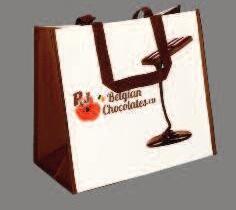
truffles, little seashells so precisely moulded the y seem almost too g ood to eat (almost). You could buy a bag of twelve for less than the price of a posh coffee back home. And not because the y ’ re cutting corners – far from it Because the y own the process, the workshop, the recipes, the packing , the know-how No middlemen No fuss.
e people behind the counter speak soly, in Eng lish if needed, always with the kind of friendliness that feels unpractised, as if the y ’ ve just remembered you ' re human too. Ask them what’s inside a particular truffle and the y’ll tell you ever ything : the g anache, the percentag e, the reason the y use a touch of hazelnut oil “ because the
cocoa butter alone g ets a bit shout y. ”
And then there are the groups. Coach loads of schoolchildren, pensioners, Rotar y Clubs, hen parties. e y come for the workshop and stay for the free samples, emerg ing sticky-fing ered and slig htly awestruck . Watching a coach group attempting to temper chocolate is one of life’s lesser-known joys, equal parts *Blue Peter* and *Bake Off*, with the odd squabble over who g ets to lick the spatula
e y do more than workshops, too Sometimes there’s a tasting with hot chocolate so thick it needs coa xing from the cup
Sometimes there’s a seasonal window filled with handpainted Easter eg g s or snow-dusted marzipan mushrooms. And always, always, there’s someone willing to open a drawer and say, “Here, tr y this we ’ re testing something new. ”
If you can ’ t g et to Adinkerke, there’s a sister shop in Z eebrug g e, and if you can ’ t g et to Belg ium at all, the y’ll post you a box throug h their rather charming ly clunky website. It’s the opposite of Amazon, a reminder that some thing s take time at’s part of the pleasure
So yes, there are slicker chocolate brands Louder ones. Ones with marble counters and celebrit y chefs But P\&J isn’t tr ying to win a beaut y pag eant. It’s the friend who still bring s you biscuits in a tin Who remembers your favourite. Who says, “Go on, have one more ”
You know the feeling when a place is better than it has any rig ht to be ? at’s MiniEurope On paper, it sounds like a novelt y hundreds of models of European landmarks, all lined up at the foot of Brussels’ hulking Atomium. But in person? It’s strang ely wonderful You stroll past the Eiffel Tower in the time it takes to unwrap a
and miniature monument is made with affection, rig ht down to the train tracks of Bavaria and the flowerbeds of Keukenhof. ere are buttons to press, boats that move, e ven a section of the Berlin Wall that crumbles dramatically Kids love it Adults pretend the y ’ re only here for the kids.But you end up learning thing s, too Each model comes with a stor y. Each flag sparks a memor y a holiday, a headline, a hope At Mini-Europe, the continent feels oddly reachable. Shrunk down to child-size, yes, but also closer in spirit

waffle Big Ben chimes on cue. e g ondolas in Venice bob g ently in their artificial canal And while there’s a small part of you thinking , “ is is ridiculous,” the rest of you is quietly enchanted.e detail is meticulous. Ever y tiny turret
Plan your visit at www minieurope e u Go with an open mind and leave with a camera full of Europe.
And you do. www.p -j.be

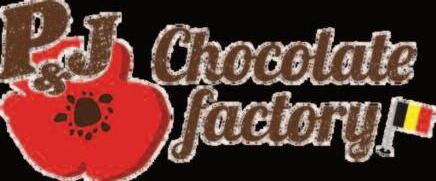

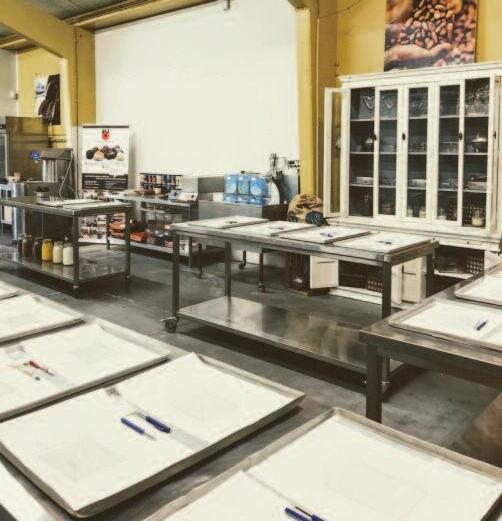
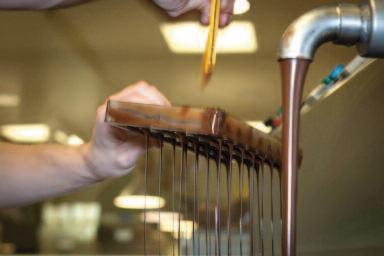

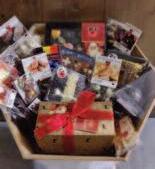
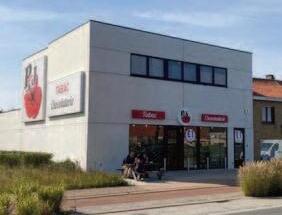
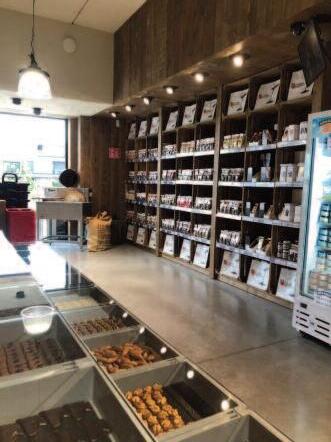
In the Footstep s of Ghosts: A Journ ey roug h Flanders Fields
Imag ine, if you will, a land where ever y furrow and hedg erow whispers tales of heroism and heartbreak, where the ver y soil is imbued with the essence of histor y –this is Flanders, a corner of Belg ium where the past isn't merely remembered, it's palpably felt.
As one traipses throug h the Westhoek reg ion, particularly around the storied town of Ypres, it's impossible not to feel the weig ht of histor y. Here, the blood-soaked battles of World War I are not mere entries in histor y books ; the y are etched in the landscape, resonating in the silence of the memorials
e Men in Gate : More an Stone and Mortar
In Ypres, the Menin Gate stands not just as a monument, but as a sentinel g uarding memories Ever y evening , as the clock strikes eig ht, the Last Post ceremony unfolds – a ritual as unyielding as time itself It's performed by local volunteers, fire brig ade chaps who, with solemn faces and a sense of dut y that transcends g enerations, remind us that remembrance isn't just an act, it's a commitment.
e Menin Gate, an enduring edifice in Ypres, is far more
than a mere congreg ation of stone and mortar It stands as a silent sentinel to the unspeakable horrors and the unspoken heroism of the First World War A A Gill, with his distinctive wit and poignant eloquence, mig ht have described it as a sombre yet sublime testament to human resilience.
As you approach the g ate, its colossal presence looms, imposing and steadfast. It's not just a structure ; it's a stor y in stone, a narrative of names – over 54,000 of them, etched into its ver y essence ese names, belong ing to soldiers whose bodies were never reclaimed, whisper tales of young lives cut brutally short of dreams unfulfilled, and of the enduring ag ony of families le to clutch at memories
In the g entle g loom of evening , when the Last Post sounds beneath the arches, one can almost hear the faint echoes of marching feet, the whispers of g oodbyes never uttered, and the silent tears of mothers, fathers, and lovers e Menin Gate transcends its physical form, becoming a portal to a past that must never be forg otten, a bridg e spanning the chasm between histor y and memor y.
Gill mig ht have mused on the irony of how such beaut y –the meticulously car ved lions, the eleg antly arching lines –emerg ed from the depths of such ug liness, the mud and blood of the trenches It is, in

its own stoic way, a monument not just to loss, but to the indomitable spirit of humanit y, a reminder that even in our darkest hours, there is hope, there is dignit y, there is a shared, unbreakable bond.
In the end, the Menin Gate is more than just stone and mortar It is a poignant emblem of the cost of war, a reverent nod to sacrifice, and a solemn promise to remember Its silent sentr y over Ypres is not just about honouring the past, but about teaching future g enerations the price of peace.
Ta lbot House : Echoes of Camaraderie

A hop and a skip away, in Popering e, lies Talbot House. Once a haven for soldiers seeking a respite from the horrors of the front, it now ser ves as a museum and B&B
It's a place that continues to welcome visitors with open arms, echoing the camaraderie and resilience of those who once soug ht solace within its walls
Talbot House, nestled in the heart of Popering e, is a tapestr y of war not woven with the usual threads of dread and despair, but embroidered with the rarest yarns of camaraderie and respite. A .A . Gill, with his acerbic wit and keen e ye for human quirks, would have found it a rich vein of humanit y amidst the inhumanit y of war. During the Great War, this house was an oasis, a rare sanctuar y where rank was le at the door. Here, amidst the horror, was a place where laug hter bubbled, where the human spirit, so battered and bruised, found a moment ' s peace Men from trenches, muddied and wearied, came to Talbot House to find a touch of home, a flicker of warmth in a world g one cold. Gill mig ht have mused on the irony of such a haven in hell, a corner of calm in the chaos. In its rooms, by its hearth, soldiers shared stories, song s, and sips of tea , stitching a patchwork of fleeting joy and brotherhood Today, Talbot House stands as more than a museum ; it's a testament to the unyielding human need for connection, a whisper from the past about the enduring power of
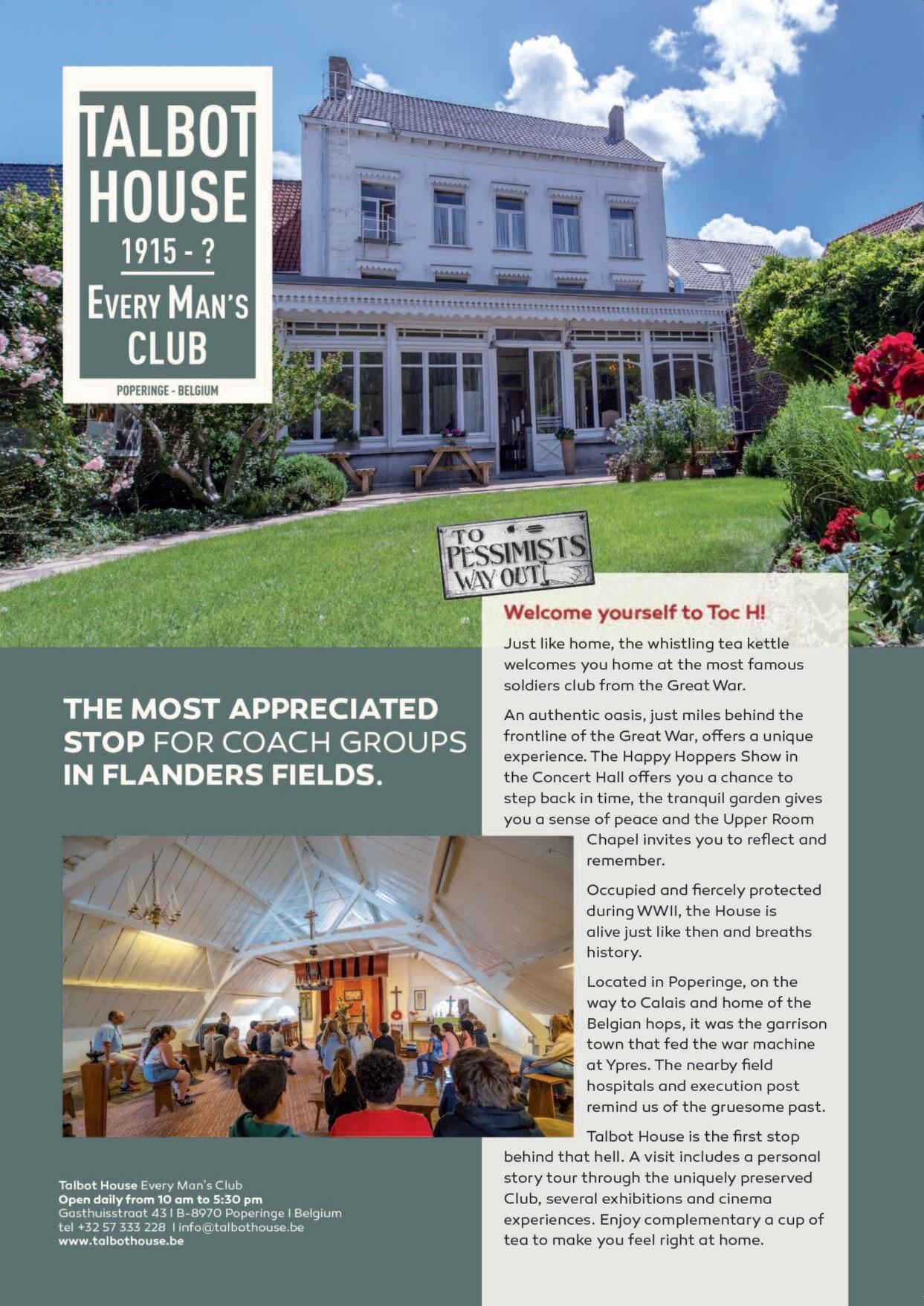
tog etherness in times of separation.
www talbothouse b e
e Passchend aele Memoria l Gard en : A Melancholic Mosa ic
In Z onnebeke, the Passchendaele Memorial Garden stands as a testament to the international impact of the conflict. Here, a German poem or a Maori song mig ht greet you, stark reminders of the g lobal tapestr y of lives touched by the war.
In the heart of Z onnebeke lies the Passchendaele Memorial Garden, a melancholic mosaic that silently narrates tales of valor and sorrow.
e g arden, with its solemn atmosphere, is a poignant tribute to the Battle of Passchendaele, a chapter written in the blood of thousands. Each flower, each blade of grass seems to stand as a silent sentinel, honouring those who fell in the muddy morass of that dreadful conflict Gill, with his unique blend of c ynicism and depth, would have reflected on the irony of such serene beaut y spring ing from the seeds of such horrific violence.
is is a place where the past whispers throug h the leaves, where each petal and path tells a stor y of human endurance amidst inhuman conditions For visitors, it's not just a g arden ; it's a journe y throug h a poignant piece of histor y, a melancholic but necessar y remembrance of the cost of war.
Susta inable Tourism : A Nod to the Future
Amidst this historical reverence, there's a keen sense
of responsibilit y towards sustainable tourism. It's about preser ving these tales, not just in g lass cases and plaques but in the way the y are told, remembered, and respected e local involvement, particularly during these pandemic-stricken times, has been poignant, hig hlig hting a communit y ' s intrinsic link to its past
Be yond the Trenches : e Allure of Flanders
But Flanders isn't all somber reflection It's a place where one can c ycle throug h landscapes that are as bucolic as the y are historic, where ever y turn of the pedal takes you throug h a stor y. e reg ion's cities – Antwerp, Brug es, Ghent – are treasure troves of art and culture, a heady mix of medieval charm and contemporar y flair.
Nestled in the heart of Ypres, Belg ium, the In Flanders Fields Museum stands as a poignant reminder of the
Great War Established in 1998, it resides in the iconic Cloth Hall, a historic building that faced near-total destruction during World War I but was meticulously reconstructed is museum is
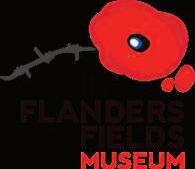
named aer the famous poem by Canadian John Mc Crae and is dedicated to the study of the First World War, focusing particularly on the battles that rag ed across West Flanders
As you enter, you ' re greeted with a unique feature : a white bracelet adorned with a red poppy, replacing the traditional ticket is bracelet contains a microchip that activates your chosen lang uag e and trig g ers the personal stories of four individuals as you explore the exhibitions. e displays tell a harrowing yet vital stor y of the invasion of Belg ium, the grueling trench warfare, and the permanent remembrance of those who fell.
e museum doesn't g lorif y war ; rather, it exposes its futilit y, especially in the context of the Western Front in West Flanders Exhibits include a diverse array of objects, interactive installations, and lifelike characters that collectively narrate the impact of the war
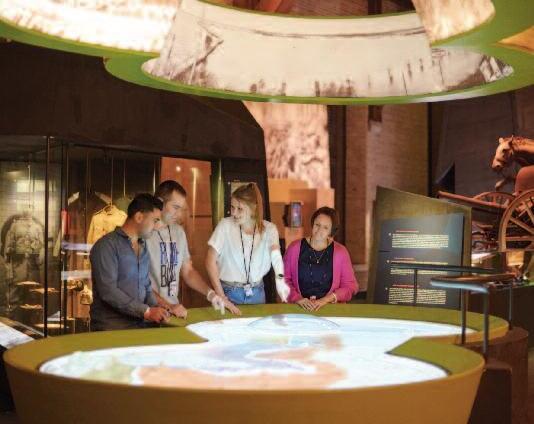
on individuals from various nationalities. You'll see medical equipment, g as masks, and even a mule and munitions wag on, providing an immersive and educational experience
One of the museum ' s notable features is the Bell Tower in the Cloth Hall, offering a panoramic view of Ypres, the surrounding battlefields, and significant sites like the Menin Gate. e museum encourag es visitors to explore these sites firsthand, extending the educational journe y be yond its walls.
Besides its rich exhibits, the museum also houses a World War I research centre, including the ambitious Names L ist Project, which aims to compile a list of all casualties in the West Flanders reg ion due to the war. e museum shop offers a selection of World War Irelated books, maps, postcards, and other memorabilia , allowing visitors to take a piece of histor y home with them
In Flanders Fields Museum is more than just a museum ; it's a tribute to the past, a lesson for the present, and a warning for the future, making it a must-visit for anyone interested in histor y, peace, and the human stor y behind the war
For more information, visit the museum ' s official website : www.inflan dersfield s.b e
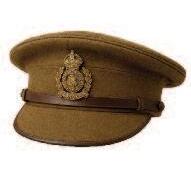
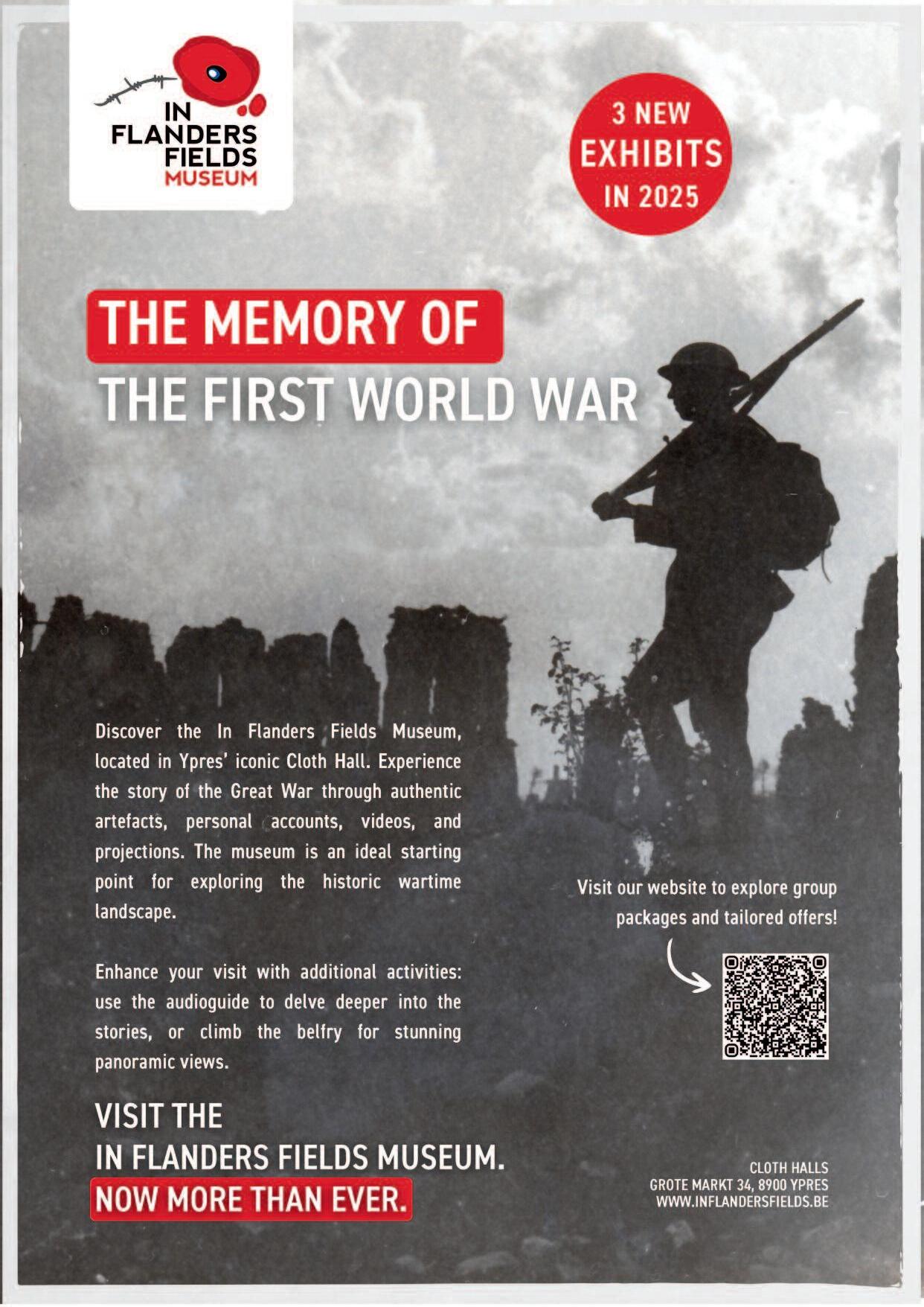
ere’s a stillness to Heuvelland that feels deliberate. e kind of quiet that settles in places that remember too much. You arrive expecting rolling hills and Flemish hospitalit y which it delivers, in spades but what you take home is something different A sense of time folding in on itself. Of footsteps that echo down throug h the decades
It’s the only municipalit y in Flanders where traces of the twentieth centur y ’ s three great conflicts are still visible, side by side. Not preser ved in textbooks or behind g lass, but in the ver y soil, the bunkers, the underground command rooms where histor y ling ers like a breath held too long .
Heuvelland Tourism has drawn inspiration from *e Ag e of Extremes* by Eric Hobsbawm, creating a g uided experience that leads visitors throug h the First World War, the Second, and the Cold War in one sweeping , sobering journe y.
You beg in at Bayernwald, where the land rises 40 metres a strateg ic advantag e that the Germans seized in 1914 and refused to relinquish for three brutal years What the y built here was a fortress, but not the kind with drawbridg es or crenellations is one was dug deep into the chalk and clay, a trench system eng ineered to outwit British tunnellers. Today, it’s been meticulously reconstructed, complete with listening shas, communication trenches, and four bunkers that bring the German perspective to life in
an unner ving ly intimate way You don't just see the war. You stand in it.
en the route lis you out of one war and drops you into another is time it’s the 1930s, and the Mag inot L ine looms into view. France, haunted by the devastation of the last war, beg an constructing a new defence strateg y André Mag inot, a veteran turned Minister of War, imag ined a wall so strong no invader would dare breach it He died before it was finished. e bunkers that bore his name outlived him and failed him On the Zwarteberg , the Hermitag e South outpost still stands, a stoic concrete g host of a flawed dream. It’s a reminder that militar y log ic, while tidy on paper, tends to unravel in real time.
But the journe y doesn’t end there. Because the twentieth centur y didn’t end with g unfire it paused with a sig h and slid into a different kind of war altog ether. One where threats were whispered and the world divided not by battlefields but by invisible lines e Cold War lives on
under Kemmel, in a command bunker started in 1952 as part of a joint air defence system uniting Belg ium, France, Great Britain, the Netherlands, and Luxembourg
You descend two floors beneath the surface, into a space once packed with telephones, radios, men in uniforms, and the kind of cig arette smoke that never truly leaves a room. O ver 50 chambers once buzzed with classified conversations Some have now been restored as a museum. Others are le untouched authentic in their 1950s austerit y. You g et the feeling that if you listened hard enoug h, you mig ht hear the quiet click of a morse ke y, or a voice from a distant room saying , “Copy that ”
It’s rare to visit a place where histor y isn’t curated but simply *present*. Heuvelland doesn’t shout about its past. It allows it to rise g ently throug h the ground, in rusted bolts and weather-stained walls, in the slope of a trench or the cold echo of a bunker corridor. It doesn’t dramatise. It doesn’t apolog ise It just


offers a chance to walk throug h the short twentieth centur y and feel how long it really was
For groups, it’s an experience of layered time, perfect for those with an interest in militar y histor y, European politics, or simply the human capacit y for endurance. Each site can also be visited individually, but tog ether, the y carr y a weig ht that’s hard to shake and harder to forg et

Information and booking s:
V isitors Centre Het Heuvelland Sint-Laurentiusplein
1B -8950 Heuvellan d-Kemmel T +32 57 45 04 55
E : toerisme@heuvellan d.be www tourismheuvelland be


a specialist guide, you will visit the following three sites:


W W I : B AY E R N WA L D :

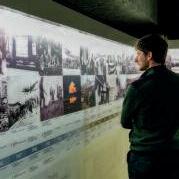


by
Heuvelland is the only municipality in Flanders where there are still traces of the three great conflicts of the previous century. Inspired by the book The Age of Extremes: The Short Twentieth Century, 1914-1991 by the famous British historian Eric Hobsbawn, H
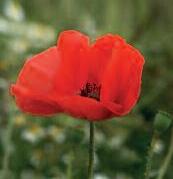
The Germans captured this 40 metre-high strategic location in 1914 and turned it into an impregnable fortress, which they held until the summer of 1917. The ingenious trench system at Bayernwald was the German answer to the mining threat posed by their British opponents Part of this system has been accurately reconstructed. Its listening shafts, trenches and four bunkers tell the story of the war from the German side.
W W I I : B U
Increasing German militarism during the 1930s forced France to build a new defensive line along its frontier. The brain behind this plan was the French Minister of War, André Maginot, a decorated veteran from the Great War. He died in 1932 but the new fortifications were named after him posthumously The Maginot bunker on the Black Mountain is of the S10 type and was known as Ermitage Sud (Hermitage South).
C O L D WA R : T H E C O M M A N D B U N K E R
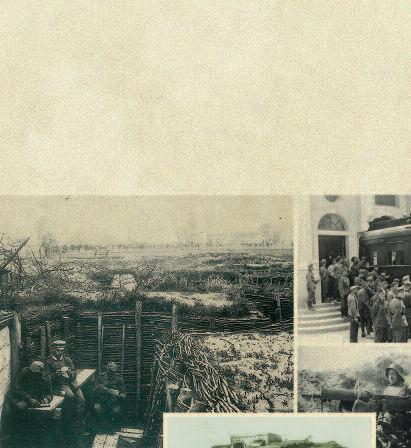

After WWII, France, Great Britain, Belgium, the Netherlands and Luxemburg decided to develop a joint air defence system Three huge underground bunkers were constructed as part of this system, with one of them – in Kemmel, started in 1952 – serving as the command post The guide will conduct you through two of the underground levels, where some of the more than 50 rooms have been turned into a museum. Wherever possible, the rooms have been left as they were during the Cold War, so that you can sample the authentic 1950s atmosphere.


All the locations in this arrangement can be visited individually
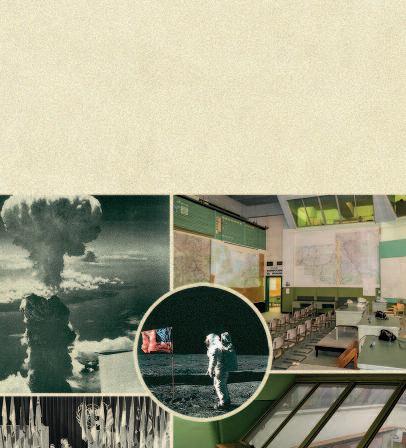


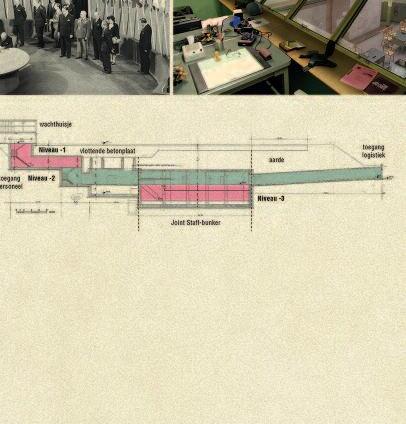
Flanders is not a place that shouts It doesn’t strut down the corridor of histor y, demanding applause. It prefers the quiet authorit y of canvas and cathedral, of brushstroke and bell tower.
ere’s a gravit y here not heavy, but grounding that settles in your bones the moment you cross the threshold e land is so soaked in leg ac y that even the pavements feel like the y were laid by painters And in many ways, the y were.
is is the cradle of the Flemish Masters, a fraternit y of brush-wielding visionaries who didn’t just document the world – the y redrew it eir influence ripples throug h time like oil across water, seeping into g enerations of artists, thinkers, wanderers. Flanders didn’t follow trends ; it started them From spires to still lifes, from Gothic to the grotesque, its output is as diverse as it is defining
All across the landscape quite literally – there are clues Belfries pierce the sky, chapels g low dimly with centuries-old pigments, and in tucked-away corners, framed madness stares back at you from behind g lass Flanders is the kind of place where even the air seems to have been varnished
A Man Ca lled Ensor
And then there’s James Ensor,
a man whose name sounds like a fog horn and whose work lands like a drumbeat
Not ever yone understands Ensor on first meeting but that’s alrig ht. He’s the sort of artist who unbuttons himself slowly First you think you ’ re laug hing . en you ’ re unner ved. en you ’ re in awe. Ensor didn’t paint what he saw. He painted what he sensed. What he suspected. What he feared and mocked and hoped for, all at once. At a time when the rest of Europe was still tang led up in realism and reverie, Ensor started pulling at the threads. He released painting from the grip of polite convention and let it breathe, snarl, grin.
To stand in front of his work is to be stared at, not the other way around His still lifes –the ones oen overlooked –are as rich as his masks and skeletons e y hum with a strang eness that creeps up on you like dusk . ere’s a sort of haunted domesticit y to them, as if the fruit bowl mig ht g et up and start whispering if you le the room.
And yet there’s g entleness too. Ensor could wield a riot of colour like a sabre, but he could also trace the soness of decay, the hush of a dying bloom His work doesn’t settle neatly into categ ories. It jostles. It jokes. It jabs. Still L ife, Still Moving
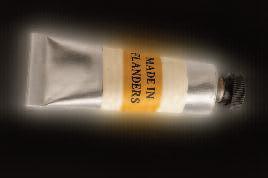
In the world of Belg ian still life, Ensor ’ s contributions sit like punctuation marks in a long , winding sentence. He emerg es from a tradition that had become too comfortable, too ornamental. Where once there were lush arrang ements designed to please the e ye and nothing more, artists like Ensor and his contemporaries beg an to push e y broug ht tension back into the frame. Meaning . Oddness. Wonder.
e y weren ’ t alone. Before them came the decorative eleg ance of artists like Antoine Wiertz and Frans Mortelmans. Oen forg otten now, their work was rich with cra and detail, if not always innovation. Among them, women artists such as Alice Ronner and Georg ette Meunier quietly car ved out space, their brushwork defiant in a world that oen didn’t notice.
en came the shi. Painters like Louis evenet and Léon De Smet kept to the rules but pressed g ently ag ainst the edg es. Others Leon Spilliaert, Gustave Van de Woest yne, Frits Van den Berg he – broke throug h entirely. e y didn’t just paint objects ; the y imbued them with emotion Tension. A kind of internal weather
And there, flickering among them like a grin behind a mask, was Ensor
To really understand any of this, you have to g o walking You need to stand on cobbles still grooved by cartwheels, lean ag ainst church doors that have heard confessions older than most countries, and duck into museums that feel more like vaults of the subconscious.
Start in Ant werp.
Not because it’s first, but because it refuses to be second. is is Rubens’ cit y –and he is ever ywhere. Not just in oil and canvas but in spirit e Cathedral of Our Lady wears his work like a crown. Saint James’ Church practically hums with it And at the Royal Museum of Fine Arts, his painting s command entire rooms Here, Rubens is not a fig ure of histor y. He’s a living presence
His house currently under wraps for renovation – is more than bricks and mortar It’s a statement A challeng e A palace of possibilit y. Rubens didn’t merely paint Baroque He lived it He was a statesman with a palette, a diplomat in a doublet. His canvases breathe like operas ere’s swag g er and theatre, but also delicate intimac y. He could paint g ods and peasants, battlefields and bedsheets, oen all on the same canvas
e Other Cities Speak Brussels, not to be outdone,
offers a more introspective tone. is is where Ensor once came as a teenag er, wide-e yed and raw, chasing the spark of art. e capital g ave him chaos, inspiration, contradiction. He responded with brushstrokes. Today, the Royal Museums of Fine Arts carr y much of that torch. eir collection of Ensor ’ s works is more than a showcase. It’s a map. A puzzle. A g limpse into the head of a man who saw the world throug h warped g lass and found it all the more beautiful for it
Across the cit y, in quiet g alleries and curious corners, his influence ling ers like the smell of turpentine. Masks,
madness, joy, sorrow – all held tog ether in the grip of a man who understood that the truth is oen too strang e to be shown straig ht.
In Ghent, the Museum of Fine Arts holds one of Ensor ’ s most beloved pieces – the Old Lady with Masks. It’s a painting that doesn’t so much invite the viewer in as dare them to look . L ike much of Ensor ’ s work, it plays at the edg e of comedy and discomfort You never quite know which side you ’ re on.
And en ere’s Jan
But before all this – before Rubens’ grandeur and Ensor ’ s anarchy – there was Van Eyck Jan van Eyck was a pioneer in the truest sense. He didn’t just
paint better than others ; he painted differently. While others were fussing over composition, he was quietly revolutionising the medium itself, developing oil techniques that made lig ht bend, sparkle, and breathe.
His Ghent Altarpiece – still ensconced in St. Bavo's Cathedral – is less a painting and more a revelation. Ever y detail, from the lamb’s e yes to the folds of fabric, seems touched by something divine Van Eyck wasn ’ t illustrating faith He was inventing it Brug es, where he lived and worked, feels like one of his canvases turned inside out e Groening emuseum offers several of his treasures, each
more exquisite than the last. It’s a cit y of so lig ht and quiet master y, where you expect to turn a corner and find Van Eyck himself, brush in hand, squinting at the sky Brueg el’s Roug h Poetr y And if Van Eyck was the visionar y and Rubens the showman, Pieter Brueg el was the realist with a wink . Brueg el didn’t deal in flatter y
He painted humanit y as it was grubby, boisterous, awkward, g lorious
His scenes of peasant life are not merely quaint ; the y ’ re operatic Each fig ure could be the subject of its own novel. Ever y villag e dance is a moralit y play, ever y market scene a satire.
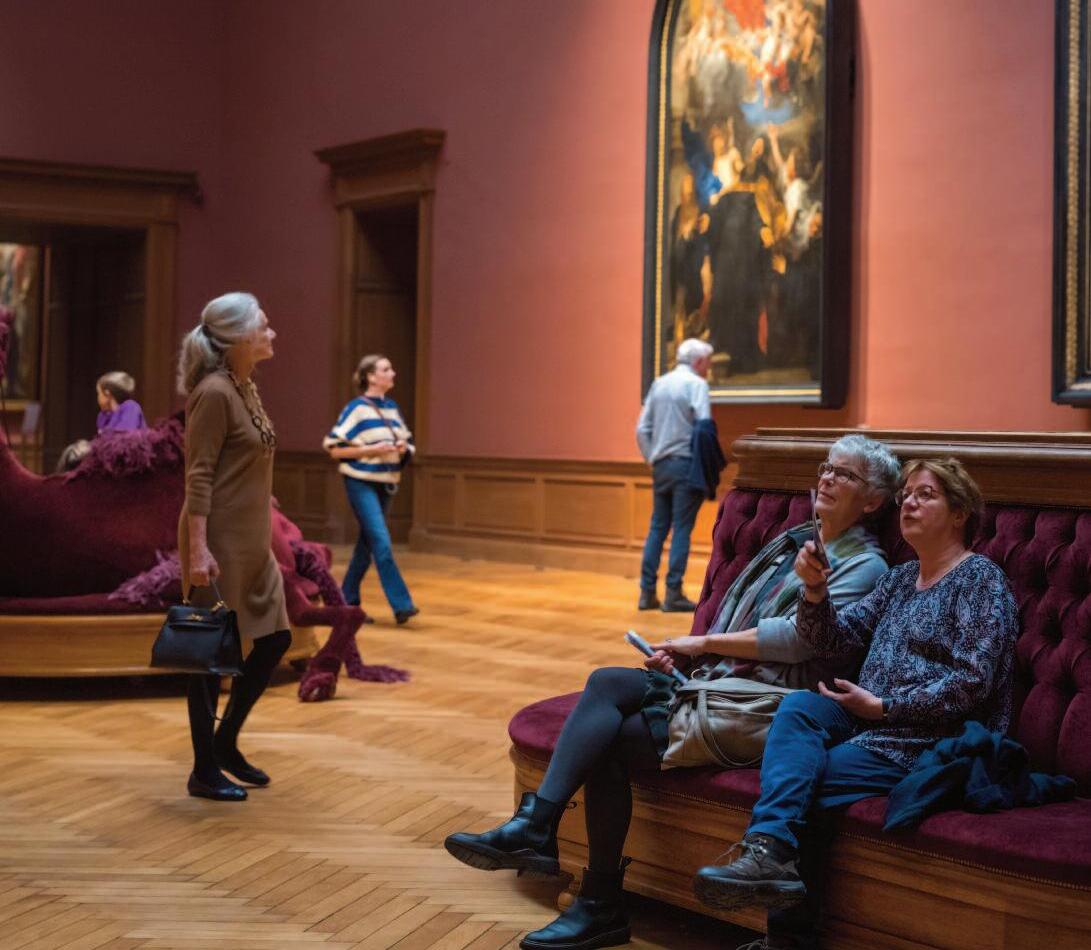

His work lives in Brussels and Antwerp now, hang ing in museums that understand the y ’ re not just housing pictures – the y ’ re holding mirrors. And what the y reflect is a world not too different from ours : full of folly, of joy, of myster y.
You can visit the places he walked, the churches where he mig ht have prayed, the streets where he looked around and thoug ht, “ Well, this is mad, isn’t it ?” And then he painted it.
Less raucous but no less vital is Dieric Bouts e quiet one e thoug htful one. A man who painted silence like others paint sun He wasn ’ t a flamboyant showman He didn’t need to be. His streng th lay in stillness
Bouts made Leuven his home, and the cit y still wears that relationship like a badg e of honour His Last Supper remains in St. Peter ’ s Church, a vision of restraint and
reverence that rewards long looking His influence, while subtle, stretches throug h the centuries like a thread throug h linen
He was a painter of atmosphere, of inwardness
You don’t g lance at a Bouts –you ling er.
e Others in the Room
And then there are the rest.
e g aller y of greats.
Hans Memling , with his serene visions and so lig ht.
Rog ier van der We yden, who could make ag ony look like poetr y. Bosch, the wild prophet of dream and nig htmare Quentin Matsys, with his curious e ye and moral wink .
Jacob Jordaens, mythic and muscular. Van D yck, suave and sensitive, turning portraiture into theatre
David Teniers, chronicler of the alehouse Frans Hals, born under a different flag but blooded in Flemish st yle.
Adriaen Brouwer, with his
tavern brawls and sly g lances
Each adds a chapter to the stor y. Each one shaped the
chapels and cloisters, in sidestreets and under staircases
A car ved pulpit here, a
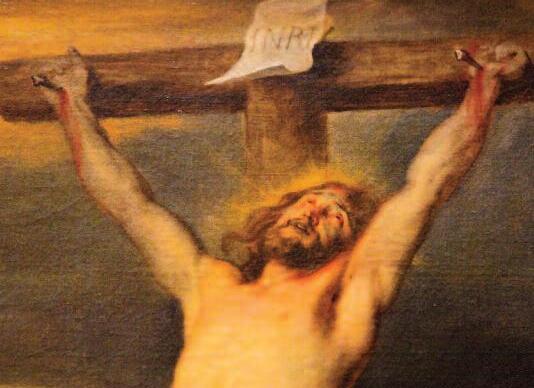
European imag ination, g iving it form, colour, pathos, and bite.
A Museum Without Walls
What makes Flanders extraordinar y is that none of this feels sealed away It’s not confined to frames and labels
e whole reg ion breathes art. It lives it
You find masterpieces in churches and town halls, in
forg otten fresco there. It’s a place that doesn’t hide its g enius. It lets you stumble into it.
ere are cities where you g o to see art. And then there are cities that are art Flanders, g loriously, stubbornly, quietly, is the latter.
And once you ’ ve walked throug h it, you don’t just remember it you carr y it with you



In Flanders, where the past ling ers like the last notes of a forg otten melody, the castles and g ardens are not just structures and spaces ; the y are chapters of a grand narrative, written in stone and petal.
e Flemish reg ion, an area of green and gre y, invites you on a journe y throug h time, where ever y castle g ate is a portal and ever y g arden path a passag e to a byg one era
Consider the Castle of Ording en, its walls echoing with the footsteps of histor y, now transformed into a sanctuar y of modern luxur y is 19th-centur y mar vel, with its five-star accolades, is more than a hotel ; it's a realm where the past is draped in the opulence of the present, offering a stay wrapped in a fair y-tale Venture to the Castle Ooidonk, a mere stone ' s throw from Ghent, and find yourself in a serene oasis. Here, the count himself welcomes you into a world where tranquillit y reigns supreme, and the luxuries of the past ming le with the comforts of today. e castle, a fair y-tale incarnate, offers deluxe g uest rooms that whisper tales of yester years in ever y ornate detail and plush fabric
In these Flemish castles, histor y doesn't just speak ; it sing s e Arenberg Castle in Leuven, now the proud

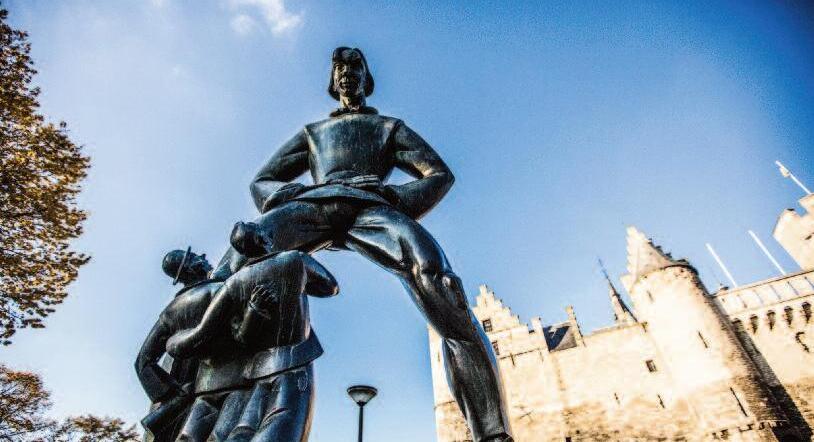
possessor of KU Leuven's art collection, resonates with the artistic leg ac y of its former residents. Here, amidst the echoes of Anthony van D yck and Peter Paul Rubens, art is not just viewed ; it's experienced, in rooms where lig ht and shadow play upon the masterpieces of yore.
And then there's the Grand Commander y of Alden Biesen, a testament to the chivalric past Founded by the knig hts of the German Order, this estate is steeped in the lore of knig hts and noblemen With its historic building s, lush parks, and vibrant g ardens, Alden Biesen is a tribute to the valor and virtue of its founders, a place where histor y and horticulture are inextricably intertwined In Flanders, these castles and g ardens are not mere tourist destinations ; the y are sanctuaries of the soul. Places
like the d’Ursel Castle, with its unique accommodations in a former painting studio, offer more than a nig ht's stay ; the y offer an immersion into the past Imag ine sleeping where once the Duchess d’Ursel pondered over canvases, where inspiration was born amidst the tranquilit y of the estate.
e Flemish castle experience extends be yond mere sig htseeing . It's an invitation to partake in histor y, to walk the halls where the past lives and breathes. It's about standing on the ramparts of the Castle of the Counts in Ghent, g azing out over the Scheldt Valle y, and feeling the weig ht of centuries underfoot
Ever y year, as spring heralds the awakening of nature, Groot-Bijg aarden Castle opens its g ates for Floralia Brussels is is not just a flower show ; it's a celebration of life and color, where over a
million bulbs bloom in unison, painting the landscape in hues of impossible beaut y
In these places, nature wears a crown, and histor y tells its tale not in words, but in the rustle of leaves, the whisper of the wind, and the silent vig il of ancient stones Here, in the heart of Flanders, the castles and g ardens are not just remnants of the past ; the y are living , breathing entities, echoing with the laug hter and tears of ag es past
In this land, ever y stone, ever y leaf, and ever y bloom is a stor yteller, and ever y visitor a willing listener, captivated by the narrative of beaut y and histor y that unfolds in the majestic castles and g ardens of Flanders.
Castles along the River S cheldt
Few reg ions can boast such a densit y of castle estates as
Flanders. e y are easy to reach from the Flemish cities by following the reg ion’s innumerable hiking trails and c ycling routes run along or throug h the castle estates of Flanders.
A prime example of this is Ghent’s Castle of the Counts : a stately base camp for exploring the Scheldt Valle y and discovering the unique network of castles along the River Scheldt between Ghent and Antwerp
Inspiration for the Flemish Masters
Castles and their oen fair ytale surrounding s appeal to our imag ination, and actually have for centuries eir surrounding s and spirit of the times were a source of inspiration to their
inhabitants and visitors – and also to the Flemish Masters. Across castle moats, behind thick walls, in eleg ant tower rooms or dusky dung eons you will find many hidden artistic g ems. ese places were perfect incubators for the arts to flourish
In the 15th centur y, the wealthy merchant Joos V ijd and his wife Elisabeth Borluut were the disting uished inhabitants of Cortewalle Castle, a moated castle situated in the heart of Beveren, in between Ghent and Antwerp e couple were the patrons of the Ghent Altarpiece, the world-famous painting by the Van Eyck brothers. e orig inal castle was once visible on the polypt ych, but unfortunately disappeared during a restoration
Arenberg Castle in Leuven is currently owned by KU Leuven It harbours the valuable art collection of the Arenberg family, including a work by the Antwerp portrait painter Anthony van D yck . His teacher ? Peter Paul Rubens
e histor y of the Bornem castle estate dates back to more than 1,000 years. Its current owner, Count John II de Marnix de Sainte Aldeg onde, has opened the castle to the public. Here, you can mar vel at historic painting s, opulently painted ceiling s and a unique collection of engraving s by Flemish Master Pieter Brueg el the Elder.
Unique castle experiences
Quite a few Flemish castles
offer unique experiences. How about spending the nig ht in a castle, or its carriag e house ? Or sleeping in a tent perched in a tree, offering phenomenal views of the castle grounds ? Why not enjoy a sumptuous meal within the castle walls, or in the g ardens ? Experience the castle. Breathe in its atmosphere
Let yourself be intrig ued by the soul of the place and the elusive essence of an extraordinar y location.
e d’Ursel Castle in Hing ene offers overnig ht accommodations in the former painting studio of the Duchess d’Ursel. e castle’s countr y estate is located just a little farther away : the De Notelaer Pavilion, where you can dig into a slice of the
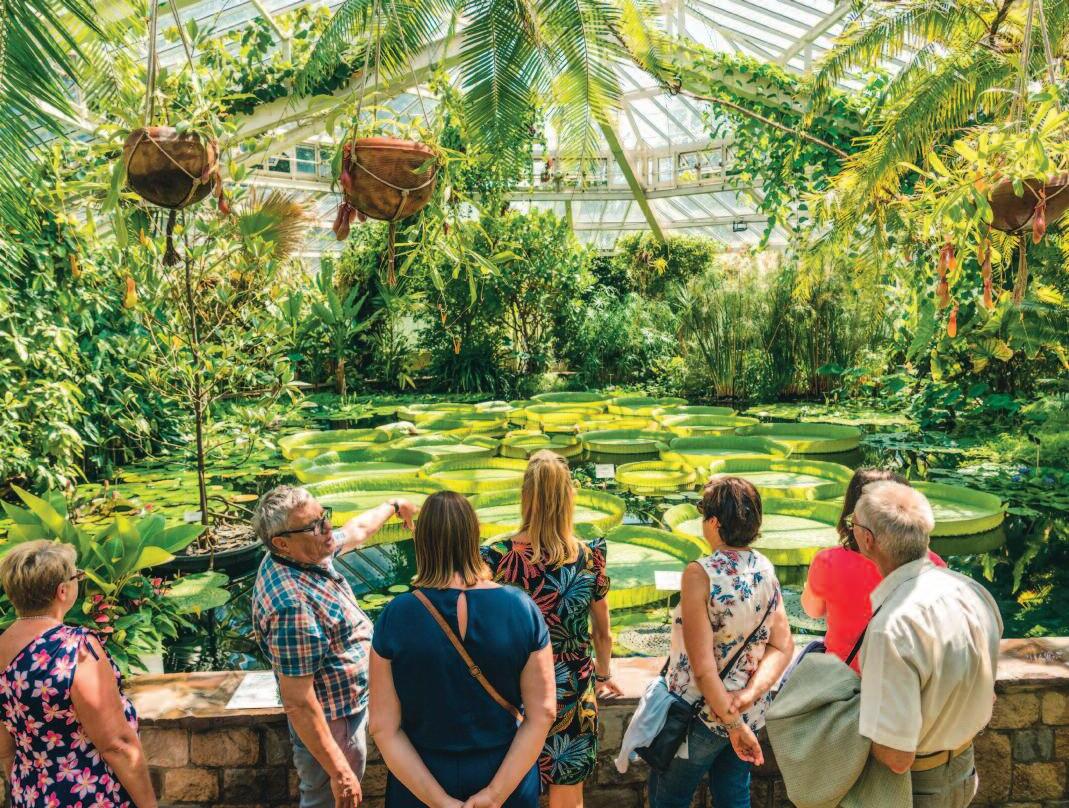

Add some wonder to your walk
• One of Europe’s largest botanical gardens
• Historic castle grounds
• 10 themed gardens and tropical greenhouses
• Local Belgian cuisine and beers
• Electric Botanic Garden Train
famous Notelaere pie. During the summer months you can also spend the nig ht in the trees, as it were, of the beautiful park domain. A unique experience !
e Castle of Ording en is a 19th-centur y countr y estate with a world-class hotel. It was even awarded five stars, making it the fourth hotel in Flanders that can boast such an accomplishment.
A mere stone ’ s throw from Ghent lies the eleg ant, stately Castle Ooidonk You can spend the nig ht here in one of the deluxe g uest rooms of this fair y-tale oasis of tranquillit y You will be welcomed there by the count himself and you can stay overnig ht in one of the luxurious g uest rooms
Nature with a crown
e larg est number by far of all Flemish castle estates are situated in a rural, wooded environment and oen have beautiful parks. Several of these literally open the g ates to stunning nature reser ves. Some castles are surrounded by eleg ant botanical g ardens Many of them open their estates to the public during special g arden days, to celebrate the beaut y of their flowers.
Spotlig ht on
Exploring the enchanting beaut y of Meise Botanic Gard en
Nestled in the heart of Belg ium, just a short trip from Brussels, Meise Botanic Garden stands as a tranquil oasis, inviting visitors to immerse themselves in the captivating world of flora and fauna . With its rich botanical heritag e and breathtaking
landscapes, this hidden g em offers an unforg ettable experience for nature enthusiasts and wanderers alike. Captivating Gardens : Spanning over 92 hectares, Meise Botanic Garden boasts an extensive collection of plants from around the g lobe
As you wander throug h its diverse g ardens, you’ll encounter a mesmerizing array of flowers, trees, shrubs, each one revealing its unique charm From the vibrant colors of the Rose Garden to the romanticism of the Island Garden, there is an ambiance of beaut y and serenit y at ever y turn.
Hidden Gems :
Meise Botanic g arden is home to several hidden g ems that will leave visitors awestruck e Plant Palace, and Green Ark, a series of g lasshouses, houses rare and exotic plants, creating an enchanting tropical paradise. e Tree Arboretum offers a delig htful stroll amidst towering trees from various continents, showcasing the awe-inspiring diversit y of the plant king dom.
Educational and Entertaining
Be yond its natural allure, Meise Botanic Garden also caters to the curious minds of all ag es.
e g uided tours provide fascinating insig hts into the
world of botany and conser vation.e interactive exhibitions eng ag e visitors in hands-on activities, making learning a joyful experience. Group Discounts
Meise Botanic Garden offers group discounts for those planning a visit with friends, family or org anization. A feast for the senses
Meise Botanic Garden is not just a visual delig ht but also a treat for the senses e fragrant aromas of blooming flowers and the harmonious sounds of birdsong create a symphony of nature ’ s wonders Pack a picnic and find a peaceful spot to savor the tranquilit y or relish a refreshing cup of tea at the g ardens’s charming café surrounded by the beaut y of nature
Whether you are seeking a peaceful retreat or a journe y of discover y, Meise Botanic Garden is a destination that will leave you an indelible mark on your heart With its breathtaking g ardens, educational opportunities, and enchanting ambiance, this botanical haven invites you to escape the hustle and bustle of ever yday life and reconnect with the beaut y and serenit y of the natural world. Plan your visit today and explore the wonders of Meise Botanic
Plantentuin Meise


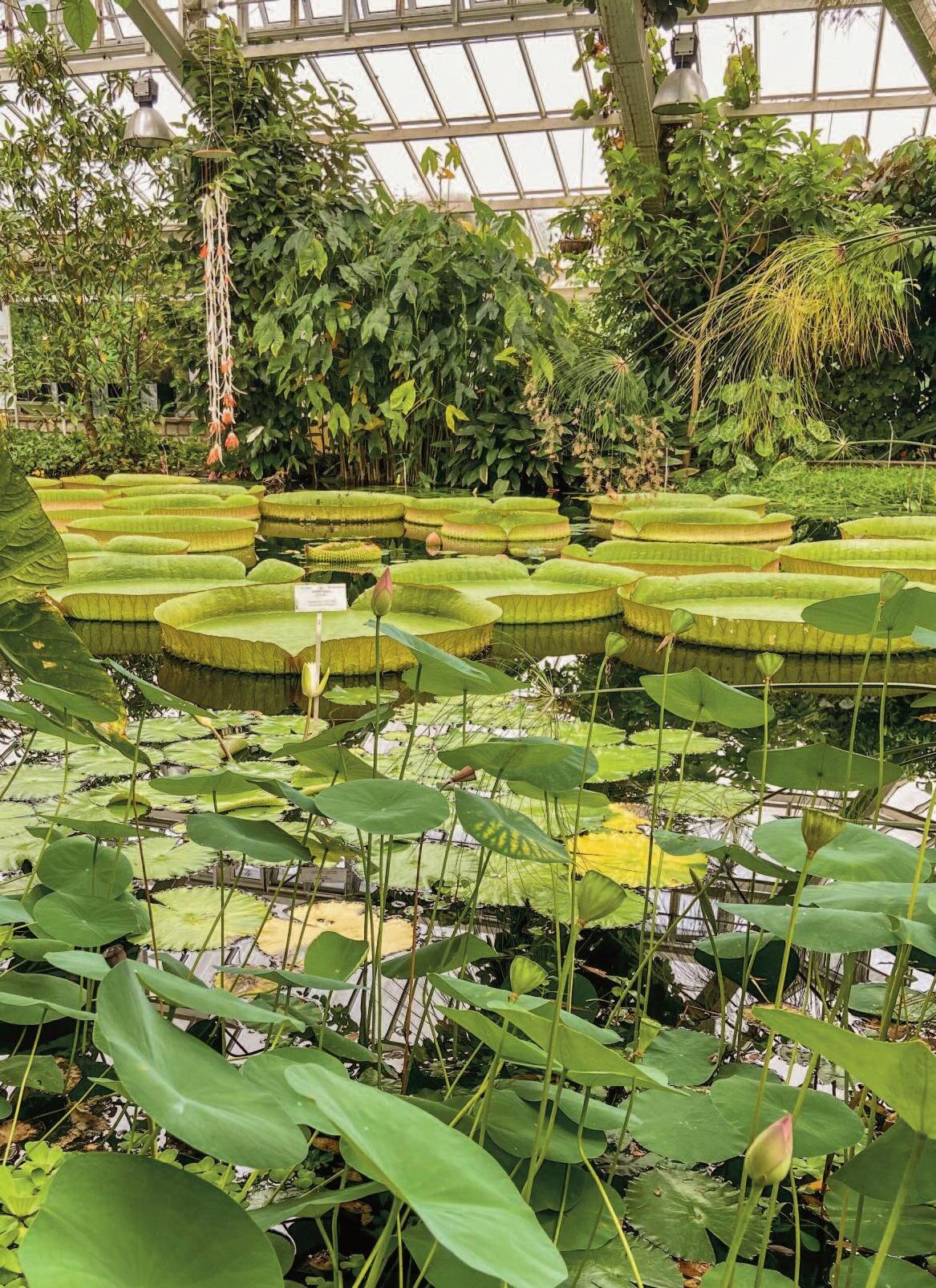
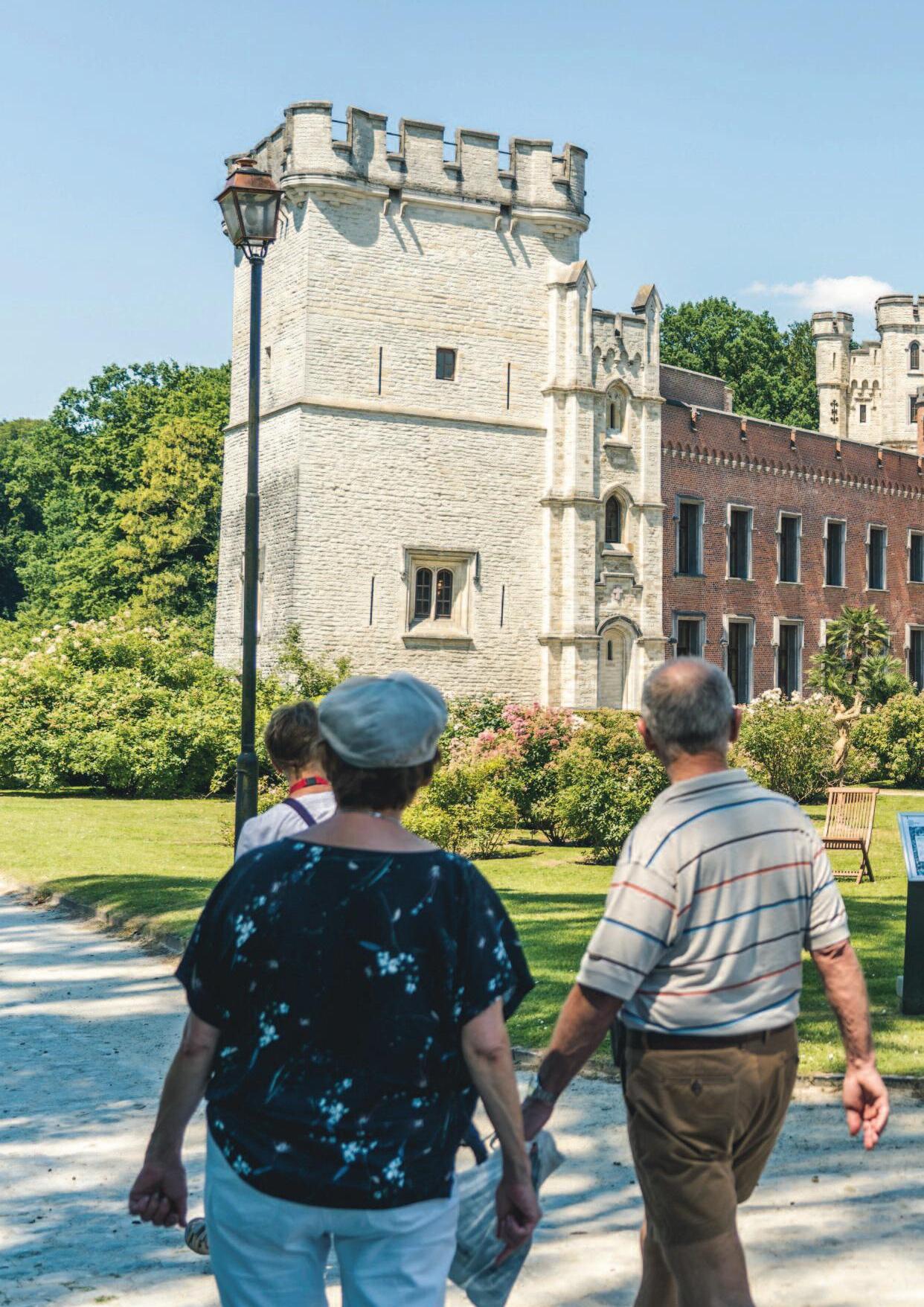
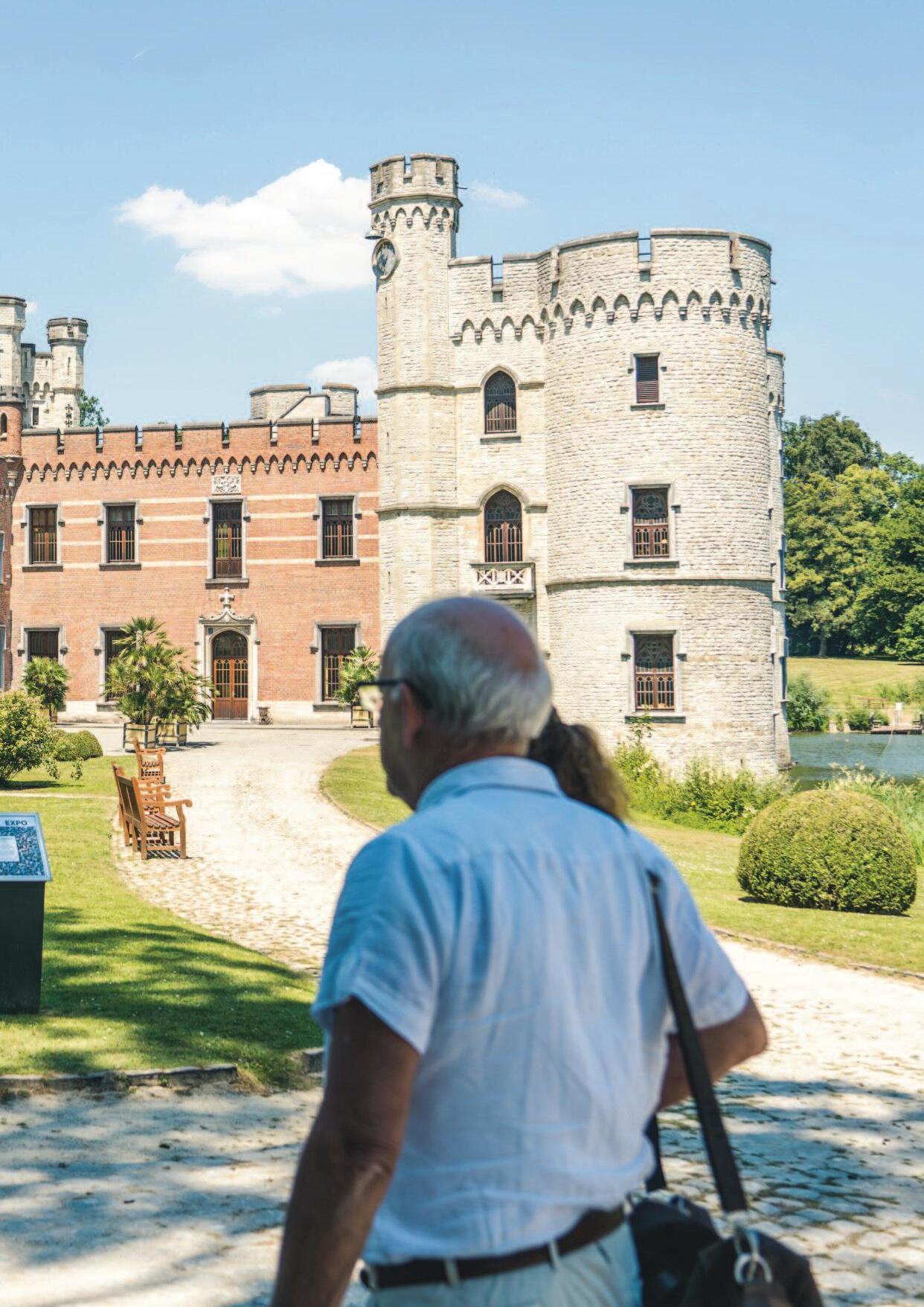
In the heartlands of Flanders, where life's simple pleasures are savored with the zeal of a well-versed epicure, a collective of passionate souls converg es, united by an insatiable "G OEST ING" - a term indig enous to these parts, encapsulating a yearning for the finer aspects of existence : chocolate, beer, and the camaraderie that music and love eng ender. is motle y crew, self-dubbed the "Ambassadors of G OEST ING," is a centre of culinar y maestros : chefs, chocolatiers, brewers, and other g astronomic artisans, each a custodian of the Flemish dining narrative, an opus yet to be fully unveiled to the world.
And then, there's Belg ian Beer a libationar y chronicle etched into the annals of Belg ium's heritag e is narrative is steeped in tradition, a continuum from the distant past to the fer vent innovation of modern brewers. Belg ium's beer sag a is a storied one, earning its place in UNESCO's Intang ible Cultural Heritag e of Humanit y It's an epic of rich traditions and bold innovations, where beers like Westmalle, Duvel, and Chimay are not mere names but symbols of a leg ac y passed down throug h g enerations
ese brewers of today's Belg ium are not mere
g uardians of tradition ; the y ' re revolutionaries in their own rig ht, experimenting with novel ingredients and methods, injecting new life into a culture revered worldwide. Belg ian beer, in its myriad forms - from the hallowed halls of Trappist monasteries to the innovative cra breweries - offers a palette of flavors and st yles as diverse as the land itself.
Belg ian beer transcends mere taste. It's an embodiment of histor y, a sensorial journe y throug h time From the early days of gruit-infused brews to the modern cra movement, Belg ian beer has weathered epochs : the Industrial Revolution's scientific enlig htenment, the tumult of wars, and the flux of g lobal trends. Yet, throug h it all, Belg ian beer has retained its soul, a testament to the resilience and creativit y of its brewers
Today, Belg ium stands at the cusp of a beer renaissance, where tradition and innovation coalesce. It's a land where beer is more than a drink ; it's a part of the national psyche, a thread in the social fabric, and a testament to a culture that values the art of living well. For the connoisseurs and the casual drinkers alike, Belg ian beer offers an experience that's not just about the beverag e but about the heritag e, the
communit y, and the relentless pursuit of "G OEST ING "
In that small, rain-soaked king dom, nestled between the North Sea and dreams of empire, lies a peculiar, g olden obsession – the humble fr y. In Belg ium, these slender, crisped potatoes are not merely a side dish but a national treasure With over 4,600 fr y stands dotting ever y villag e and district, it’s evident that Belg ians hold their fries in hig h esteem. e locals, particularly the Flemish, don't just consume these fries ; the y celebrate them. And why wouldn't the y ? With the finest potatoes, a dash of pride, and a sprinkle of skill, Belg ians have elevated fr ymaking to an art form
In this corner of Europe, what the world erroneously dubs as 'French fries' are, in truth, a Belg ian master y. e term 'friet' – a nod to their rig htful heritag e – harks back to patates frites, the Belg ianFrench term for 'fried potatoes ' A twist of fate during the First World War led American soldiers to mislabel these g olden treats as French, but make no mistake, the Belg ian fr y is a unique culinar y wonder, traditionally craed from bintje potatoes and unparalleled in taste.
Once these crispy batons are pulled from their sizzling bath, the y ' re lig htly salted

e classic ser ving is simple yet sublime : a cone of fries topped with a dollop of mayonnaise.
But it's not just about the fries. Flemish cuisine, a bastion of authenticit y and qualit y, marries local, seasonal ingredients with timehonored culinar y practices. Many of the reg ion's traditional dishes are elevated to new heig hts when paired with these beloved fries
Take, for instance, the vol-auvent, a veritable Flemish classic. is dish, featuring juic y chicken, fried mushrooms, and tiny meatballs in a creamy sauce, finds its perfect home within a crisp puff pastr y e orig ins of vol-au-vent are as clouded as a Belg ian winter's day, with some tracing its roots back to the kitchens of Versailles It was the French chef Antonin Carême who revolutionized this dish, using puff pastries lig ht enoug h to be 'carried by the wind' – hence, the vol-auvent

Mussels and fries, another cornerstone of Flemish cuisine, paint a picture of celebration. Once the Friday staple of the urban working class, these steaming pots of mussels now signif y a feast.
e Belg ians' love for mussels is not just a culinar y affair ; it's a testament to sustainabilit y.
ese bivalves convert the sea ' s plankton into nutritious proteins while purif ying the waters, grown on environmentally friendly rope installations rather than the sea bed.
And should you ever find yourself obser ving a Belg ian delicately extracting mussels with an empt y shell, know that you are witnessing a practice as uniquely Flemish as the fries the y adore
In the heart of Flanders, a nostalg ic classic reigns supreme : the beef stew. is dish, steeped in tradition and savoured in homes across the reg ion, is a testament to the art of simple, heart y cooking . It’s not just a family favourite ; even the local friteries ser ve it up g enerously over a bed of fries, each dollop of mayonnaise adding to its rich allure. e beaut y of this dish lies in its diversit y - ever y family boasts its own unique recipe, a culinar y heritag e that traces back to the Middle Ag es Its roots are in practicalit y and economy, utilizing ingredients that were readily available and affordable : inexpensive cuts of meat, onions, and the everpresent beer
e beef stew of Flanders is a lesson in patience and subtlet y. Toug her cuts of meat are transformed throug h long , g entle simmering , becoming so tender the y fall into fibres. ese are combined with
onions and submerg ed in a choice of beers – from a straig htfor ward Pils to a robust abbe y beer, or even a tang y Geuze. e unique thickening ag ents of this stew are a mustard sandwich and a jam sandwich, layered atop the simmering pot is combination imparts a distinctive sweet-and-sour flavour, a hallmark of the dish Reg ional variations abound : in L imburg , apple spread mig ht take the place of jam, while in East Flanders, a slice of g ing erbread is oen used instead of the sandwich, lending each version of the stew its own local character.
e stew ' s intense, sweet-andsour flavour profile is a celebration of Flemish reg ional produce, from the beer and mustard to the apple spread
Another Flemish favourite is the shrimp -filled tomato, ser ved along side crispy fries and homemade mayonnaise. is dish, simple yet divine, harks back to a time when North Sea shrimps were considered a luxur y, reser ved for special occasions e earliest recorded recipe dates back to 1926, published in 'De Boerin' by the Boerinnenbond, the farmers' wives union. Orig inally, the tomatoes were halved and topped with a slice of hardboiled eg g . O ver time, the preparation evolved : now, the top of the tomato is sliced off, creating a g enerous cavit y to be filled to the brim with shrimps e hard-boiled eg g s, once perched atop, now rest beside this maritime treasure, accompanied by g olden fries
Belg ium is renowned for its extraordinar y chocolatemaking heritag e, dating back centuries. Particularly,
Flanders is oen hailed as the epicentre of chocolate, notably housing two of the world’s larg est chocolate factories, Callebaut and Puratos But Belg ium’s fame in the chocolate world isn’t merely about its long -standing histor y ; it's also about the exquisite qualit y and artistr y of its pralines, first craed in Brussels' renowned Galeries Royales Saint Hubert. is rich tradition, coupled with easy access to premium ingredients, ensures the continual passing down of chocolate expertise throug h g enerations
e world of Belg ian chocolate is one of constant innovation. Master chocolatiers like Herman Van Dender, Pierre Marcolini, and Dominique Persoone are at the forefront, embracing new technolog ies and craing unexpected flavour combinations – think wasabi and earl gre y tea – and pioneering the bean-to -bar movement. eir talents have earned them accolades in international competitions like the Patisserie World Cup.
Making Belg ian chocolate is an art requiring immense skill and dedication Chocolatiers meticulously roast cacao beans to perfection, handcra g anache, and strive to achieve the ideal balance and texture in each praline. It’s this attention to detail that sets Belg ian chocolate apart, making a box of pralines more than just a sweet treat – it’s a piece of Belg ian culture
Unique to Belg ian chocolate is its fine structure, oen ground to just 15 to 18 microns, a hig h cocoa content, and the exclusive use of pure cocoa butter. e careful selection of hig h-
qualit y cocoa beans contributes to its distinctive qualit y e Belg ian chocolate sector boasts a diversit y of producers, from larg e players like Callebaut and Belcolade to medium-sized companies and numerous small chocolatiers, each spreading the fame of Belg ian chocolate with their creativit y and innovative flavours
In Belg ium, chocolate is not just purchased ; it’s an experience V isitors can explore chocolate museums, take part in praline-making workshops, and even enjoy chocolate and beer pairing s. e 'Belg ian Chocolate Code' established in 2007 ensures the authenticit y of Belg ian chocolate, and with the world’s larg est chocolate factor y located in Wieze, Belg ium’s chocolate influence is undeniable
Flanders excels in the world of pralines too e first Belg ian praline was created in Brussels by Jean Neuhaus, who initially coated medicines in chocolate at his pharmac y. His grandson later innovated by replacing the medicine with delicious filling s. e ' ballotin', a decorative box for chocolates, was introduced by Louise Ag ostini, Jean Neuhaus Jr.'s wife, further establishing pralines as a luxur y item
Tasting Belg ian pralines is an art, demanding a refined palate and attention to ever y sensor y detail. It’s not just the sweetness that matters but also the texture and balance of flavours. Modern Belg ian pralines have evolved to use purer, less sweet chocolate, offering a vast array of tastes and textures
Belg ian pralines remain in demand g lobally, thanks to
the hig h qualit y of local butter and cream. Today's chocolatiers continue to innovate, not just in recipes but also in choosing beans, production methods, and machiner y.
For chocolate enthusiasts, a visit to Belg ium is incomplete without experiencing the rich array of top chocolate brands like Godiva , Leonidas, Côte d’Or, and Neuhaus. ese brands, along side a host of top chocolatiers, represent the pinnacle of chocolate-making , combining traditional

crasmanship with modern innovation. Whether it's exploring chocolate shops, participating in tasting s, or creating your own pralines, Belg ium offers a unique and delig htful chocolate experience.
Crispy, g olden fries : the y ’ re their national pride Did you know that Belg ium has more than 4 600 fries stands ? at means you can find one in ever y district and villag e. e locals adore them! For the Flemish, fries are anything but a side dish.
Belgian fries, not French fries
While the y may be known across the world as ‘French fries’, there’s nothing French about them. e name ‘friet’
comes from patates frites, Belg ian-French for ‘fried potatoes ’ One possible explanation for the association could have been formed in the First World War, when American soldiers were introduced to ‘fried potatoes ’ in Belg ium, but thoug ht the y were in France because that was the lang uag e spoken in that reg ion Whether you call them Flemish or Belg ian, our delicious fries are made from bintje potatoes per tradition, and are the tastiest you’ll find anywhere on the planet
Once your order is prepared, these crunchy g olden batons are seasoned with a little salt e most popular order is a cone topped with mayonnaise ; simple and delicious.
Flemish classics with fries (of course)
e reg ional cuisine stands for authenticit y and qualit y. It sets great store by using local, seasonal ingredients As you mig ht expect, many of the most popular and traditional dishes are also fantastic when
enjoyed with a portion of fries. Bring out the foodie in you and enjoy all the deliciousness that Flanders has to offer with these great specialties
“We don’t see fries as fast food, but as art We take the time to prepare them as they should be ”
Wim Ballieu
Chef Wim Ballieu
Juic y pieces of chicken, fried mushrooms and small meatballs in a silky cream sauce : it’s enoug h to make your mouth water ! Spoon this sauce into a crispy puff pastr y shell and you have one of our most popular Flemish classics : vol-au-vent. Althoug h vol-auvents are also common in the kitchens around us, the Flemish method of preparing this dish is unique. It is only here that the puff pastr y cup is filled exclusively with a creamy poultr y fricassee.e histor y of the vol-au-vent is shrouded in myster y. According to some sources, the dish was named aer
Maria Leszczynska , wife of Louis XIV. She was so fond of poultr y fricassee that in the kitchen of the Palace of Versailles people started talking about a ‘ bouchée à la reine’, or ‘ queen ’ s morsel’, as our vol-au-vent is also called.
What is certain is that the fricassee was first packag ed in crumble or shortcrust pastries, which have been popular for centuries. at is until French chef Antonin Carême started experimenting with puff pastries, which were so lig ht the y could be carried by the wind : the vol-au-vent was born!
A big pot of steaming mussels ser ved with g olden yellow fries – now that’s a celebration! However, mussels were not always reser ved for special occasions : in the 19th centur y, mussels & fries were on the menu of the urban working class ever y Friday (fish day !). e mussels were transported fresh from the North Sea by boats to the major cities. You could buy a few kilos of mussels directly

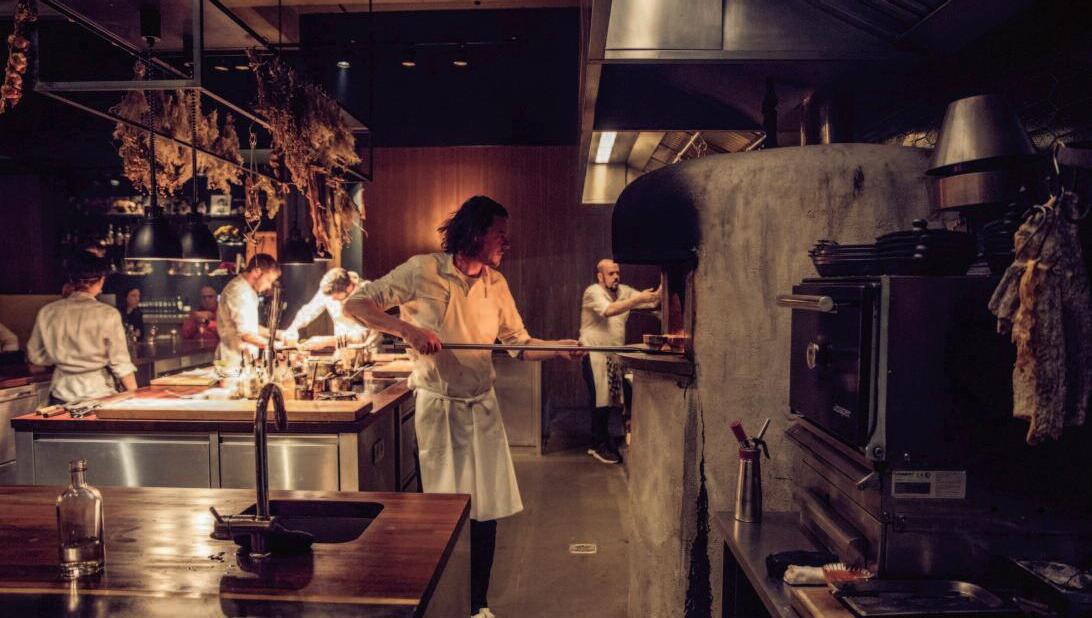
from these small boats on the quays of Ghent, Brussels and Antwerp
e statistics confirm that we are mad about mussels : we eat an impressive 27,000 tonnes a year in this countr y. at amounts to around 3 5 kg per person. Mussels are also extremely g ood for you : the y contain little fat and are packed with vitamins and minerals. e season for our North Sea delicac y runs from July to Februar y You can enjoy a classic ‘natural mussels’ with onion and celer y, accompanied by a dip of mayonnaise, mustard and a dash of broth But did you know that you can also eat mussels raw ? ese ‘moules parquées’ are a Brussels specialit y e literal translation for this dish is ‘parked mussels’, so -called because the y are ser ved beautifully in a row. e orang e flesh of the raw opened mussels tastes less salt y than that of an oyster ; the flavour is rather creamy and sweet From a technical point of
view, mussels are an ideal staple to feed the world. e y turn the sea ’ s plankton, which we humans can ’ t eat, into nutritious proteins. And, in the meantime, the y purif y the sea . As increasing use is made of mussel seed capture installations, this cultivation technique is also environmentally friendly : the tiny mussels grow not on the seabed, but on ropes that hang in the water. is allows them to be har vested easily without causing damag e to the seabed
Do you know how to recognise a Flemish person eating mussels ?
By the empt y shell the y use to eat the mussels – a practice you won ’ t find anywhere else !




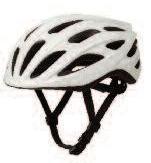
Flanders is renowned as the birthplace of c ycling , an intrinsic part of its heritag e.
e prevalence of c ycling in Flanders is second only to the Netherlands, with many choosing to c ycle for their daily commutes. e reg ion's hills and cobblestones provide an exhilarating challeng e for g enuine Flandriens. Group c ycling enthusiasts are well catered for with various c yclotours, while those preferring a leisurely exploration of Flanders can embark on one of nine iconic c ycle routes.
e Flandrien Challeng e poses a question : Do you have the mettle to be a true Flandrien? is individual must possess an indomitable spirit, persevering even when faced with the grueling demands of the reg ion's famed mountain and cobblestone segments e challeng e, hosted on ST R AVA , involves conquering 59 iconic segments in under 72 hours Successful challeng ers earn a personalized stone on the Centre Tour of Flanders' wall of fame in Oudenaarde.
Aspiring to World Champion status ? Experience the thrill of the world champion by undertaking one of the bucket list challeng es, such as the 2021 Road World Championships course is route features eig ht
challeng ing climbs, winding roads, and cobblestone sections, set ag ainst a picturesque backdrop Cyclists can indulg e in a refreshing beer at various bike pubs and breweries along the route or celebrate their achievement in Leuven, the home of Stella Artois
For those preferring company on their rides, c yclotours offer an excellent opportunit y Participants can join fellow c ycling enthusiasts on routes like the World Championships course or the Tour of Flanders ese events, scheduled throug hout the year, allow c yclists to experience the excitement of the c ycling classics, offering camaraderie and the chance to
Flanders also caters to those who enjoy c ycling at a more rela xed pace with its nine iconic c ycle routes. Each route, themed and linking beautiful landscapes, is fully signposted in both directions, offering flexibilit y in starting and ending points. Notable routes include the Front Route, traversing the Great War's former front line, and the Meuse Route, showcasing stunning vistas along the Meuse
Whether you ' re a seasoned c yclist or a casual rider, Flanders welcomes you with a diverse rang e of c ycling experiences to suit ever y preference.
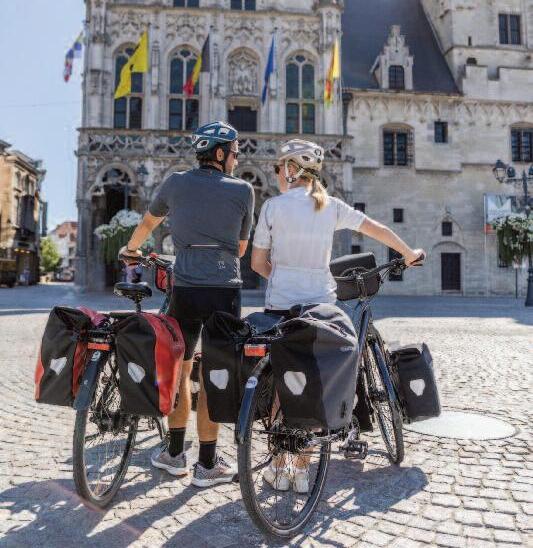

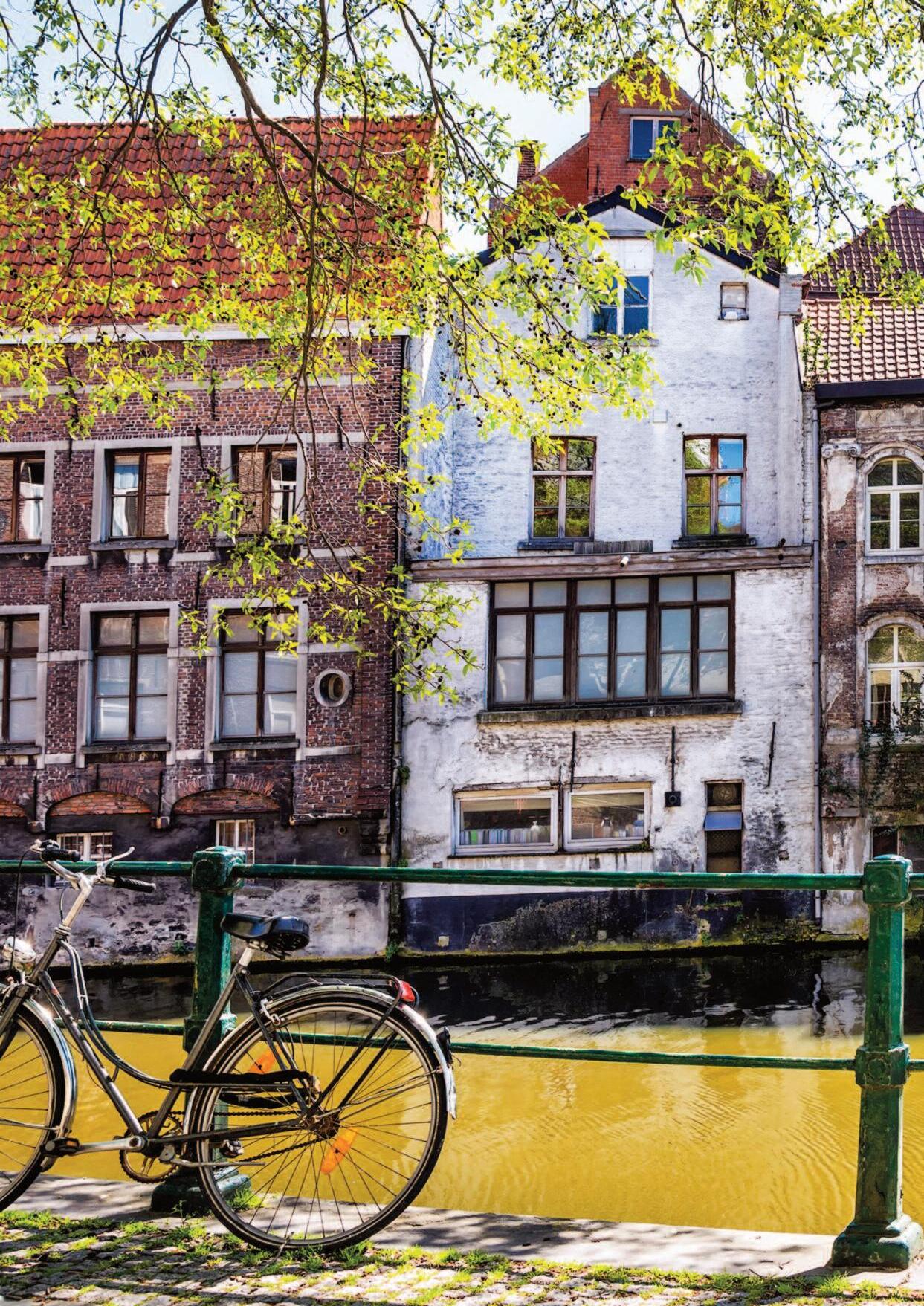
Flanders, in its snug embrace, hosts a constellation of art cities, each a mere pebble's toss from the next. A journe y bet ween these cultural bastions is a brief affair, oen under an hour, whether by the iron steeds of the rails or the swi chariots of the road
Yet, Flanders' tapestr y is woven with more than just these urban jewels. Venture forth and uncover the lesserknown, yet equally dazzling , heritag e g ems nestled in its reg ions, each a canvas of natural splendour
Kor trij k, cradled in the Leie reg ion, presents an enchanting tableau Here, the g randeur of an urban heart beats within the comfort of a villag e soul e Leie river, once the lifeblood of the fla x trade, now serenely enhances the cit y ' s picturesque qualit y Its banks, shaded by the stoic Broel Towers, offer a tranquil respite, a perfect preamble to the cit y ' s vibrant core. Explore Kortrijk's rich tapestr y of histor y at the Beg uinag e and Belfr y, the Kortrijk 1302 multimedia museum, and the Texture museum, dedicated to its textile leg ac y. e cit y centre, a lively meld of ancient relics, modern desig n, and unrestrained creativit y, beckons for a leisurely exploration.
In Kortrijk, the quaint charm
of a hamlet and the dynamism of a metropolis coexist harmoniously It's a place of delig htful contradictions : serene in the hushed court yards of the Beg uinag e, yet alive with the pulse of countless e vents. Here, histor y and modernit y walk hand in hand, offering a feast for the senses – from haute cuisine to trendy street eats, g lobal flavors to chic cocktail loung es, and artisanal coffee houses Embark on a nautical adventure along the Lys, delve into the leg ac y of fla x at the Texture museum, or bask in the ambiance of the river's sun-kissed terraces
Ostend, the sovereig n of seaside havens, lives up to its reg al epithet with aplomb is jewel of the North Sea marries Belle Époque splendor with the artistic ver ve of James Ensor and his ilk In its streets, art e vents like Beaufort Triennial and e Cr ystal Ship have woven their mag ic, leaving a lasting imprint Ostend of today is a canvas of artistr y and modernit y, pulsing with life, yet deeply rooted in its heritag e as a fishing enclave, sometimes bracing ly raw. Its eateries, rang ing from the unpretentious to the exquisite, ser ve up the ocean ' s freshest bount y : shrimps, mussels, and sole.
Along the Flemish Coast, a
67-kilometer stretch of sandy shores unfolds from France to the Netherlands It's a tableau of 13 seaside resorts, each with its unique persona and stor y De Panne's expansive beaches beckon walkers ; Koksijde boasts traditional fishing roots ; De Haan exudes Belle Époque eleg ance. Amidst this, the Zwin nature reser ve offers a tapestr y of biodiversit y. is coast is a ne ver-ending odysse y, traversed on foot or aboard the world's leng thiest tram line, ferr ying you to the coast ' s myriad wonders
Hass elt, the heart of L imburg , a cong enial atmosphere pre vails is welcoming cit y, rich in jene ver and speculaas, boasts Europe's larg est Japanese g arden, quaint squares, and heritag e sites like St Quentin Cathedral and Herkenrode Abbe y. Contemporar y art melds with a cornucopia of g astronomic delig hts Hasselt, rig htfully anointed the "Capital of Taste," offers a culinar y odysse y par excellence.
L imburg , a veritable Eden, mig ht just be the most amiable of provinces. Here, landscapes of heart-stopping beaut y create a paradise for those on foot or on t wo wheels Cycling in L imburg is a symphony of unique experiences : Where else does one pedal amidst the
treetops, g lide throug h water, or traverse a National Park? Haspeng ouw, with its fruitladen orchards, is the north's answer to Tuscany, a dreamy tableau for any who seek tranquilit y.
For those with a cultural appetite, Genk, once a mining strong hold, now boasts the C -Mine, a cultural behemoth. In Tong eren, Belg ium's most ancient cit y, histor y hang s so heavily in the air it's almost palpable. L imburg is a province that always promises more
Ypres, the heart of Flanders Fields, is a town of solemn remembrance Its Cloth Hall, g rand Cathedral, and medie val Market Square are but preludes to its poig nant histor y from a centur y ag o. As the de facto capital of Flanders Fields, Ypres is a testament to the First World War's brutal battles e In Flanders Fields Museum and the Menin Gate memorial, with its nig htly Last Post ceremony, ensure the war ' s memor y endures.

Spectacular!
Be amazed Mini-Europe is a park featuring all the wonders of Europe, in miniature Bonsai trees, flowery groves and dwarf trees embellish the 350 monuments which have been reproduced at scale 1/25 Thousands of lifelike figurines and animations! Set offthe eruption of the Vesuvius and admire the takeoff of the Ariane rocket The two hour walk, which is both entertaining and educational, will let you (re)discover the 27 member states of the European Union and the UK, their historical, architectural and cultural wealth
Fun!
A trip full of surprises Take the controls of the many opportunities for interactive live action that stud the route.
Fascinating!
Have fun learning! Behind the captivating universe of the miniature monuments, the dramatisation and
live action, relive our surprising common history with its values and Greek, Roman and Viking heritages You will find commentary at every stage of the journey in the free catalogue that is teeming with information and anecdotes that will delight children, those with a sense of curiosity and those passionate about history
Did you know?
Unrivalled quality of artistry
The Cathedral of Santiago de Compostela alone involved 24,000 hours of work At 13 meters, the Eiffel Tower is taller than a 3-storey building
Indoor space.
Located at the end of the park, the ‘Spirit of Europe’ welcomes you into a large covered space where live action models, games and quizzes will give you the chance to test, enrich or perfect your knowledge of the European Union
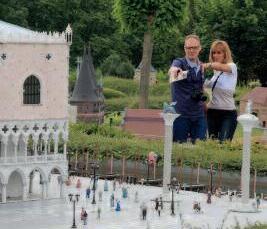
...
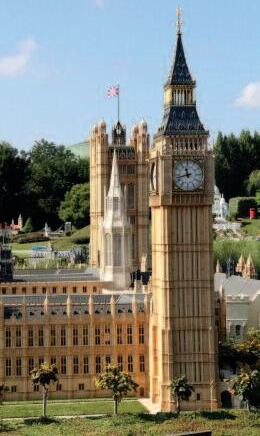


Fascinating presentation for everyone, not to be missed during your stay in the capital of Europe !
Flanders Field, immortalized by John Mc Crae's poig nant verses, is a hallowed g round where the First World War unfurled its darkest chapters.
e Westhoek bore witness to unspeakable trag edies : a million soldiers dead, wounded, or missing , entire towns erased is land, studded with monuments, cemeteries, and museums like Tyne Cot Cemeter y, Westfront Museum in Nieuwpoort, and Memorial Museum Passchendaele, stands as an eternal, silent witness.
Oudenaarde, nestled on the Scheldt's le bank, is a provincial jewel with a g lobal c ycling renown Its lateGothic town hall, Cloth Hall with exquisite tapestries, the Beg uinag e, and the MOU museum are but hig hlig hts of this Flemish Ardennes g em. For a centur y, its undulating roads and cobbled hills have been pivotal in Flanders’ spring classics, a tale eloquently told in the Tour of Flanders Centre.
e Flemish Ardenne s, synonymous with c ycle racing , presents a landscape of wide valle ys, cobbled climbs, and verdant Scheldt banks – the traditional stag e for Flanders' spring classics Iconic challeng es like the Muur van Geraardsberg en and Oude Kwaremont are the proving g rounds for any true Flandrien Yet, be yond c ycling , it offers rolling hills, sweeping vistas, and treasures like the Muziekbos, inviting families to indulg e in both exertion and rela xation amidst its splendor.
Brussels, stands Gaasbeek Castle, a venerable bastion dating back to 1236. Initially part of Brussels' defenses, it later morphed into a sumptuous retreat for the nobilit y Now, it's a trove of art and heritag e, brimming with antique furnishing s, tapestries, painting s, precious metalworks, stained g lass, and sculptures – a collection nearing a thousand pieces is historical splendor is complemented by a verdant castle park and Museum Garden, a modern Eden offering serene respite.
Paj ottenland, the verdant outskirts of Brussels, presents a visual feast : expansive landscapes, parks, forests, g ardens, majestic castles, and timeless heritag e. For centuries, it's been a muse, inspiring the likes of Brabant's Pieter Brueg el the Elder Here also lies the cradle of Geuze beer. Breweries like 3 Fonteinen, Brouwerij Boon, and Oud Beersel cra this unique, slig htly sour, effer vescent brew throug h spontaneous fermentation – a taste sensation unparalleled elsewhere
D endermonde dances to the beat of folklore and histor y Here, the Ros Beiaard, a leg endar y wooden horse, reig ns supreme, parading throug h the cit y e ver y decade in a celebration of epic proportions e cit y also boasts the Grote Markt, with its Cloth Hall and Butchers’ Hall, not forg etting the Belfr y, a UNESCO World Heritag e Site where 49 bells chime, orchestrated by a carillonneur Dendermonde's heritag e resonates deeply.
land of Aalst, Dendermonde, and Ninove, crisscrossed by the Scheldt, Dender, and Rupel rivers, thrived on trade and industr y thanks to these water ways. eir towpaths and lanes make for picturesque walks and bike rides. Folklore is alive here, with Aalst and Ninove known for their exuberant carnival celebrations.
Turn hout, in the heart of the Kempen, exudes warmth and histor y Its 14th-centur y Beg uinag e, a UNESCO site, and the e ven older Turnhout Castle, known as the Castle of the Dukes of Brabant, are just starters. Be yond histor y, Turnhout offers delig htful shopping , a splendid cit y park, and an unpretentious charm. Welcome to Turnhout
e Kempen, g reen, friendly, peaceful is reg ion is a natural wonderland, boasting the Kalmthout Heath, Kampina nature reser ve, Turnhout wetlands, and Grote Netewoud forest. With nearly t wo thousand kilometers of sig nposted c ycle paths and numerous footpath net works, it's a haven for c yclists and walkers alike. e Kempen invites you to wander and lose yourself in its serene beaut y
Nestled in Paj ottenland's rolling hills, a stone ' s throw from the pulsating heart of
In the S cheldt Valle y, water is a constant companion. is
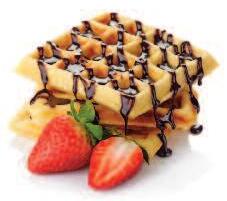


Flanders is unique Its enormous versatilit y and historical and cultural wealthconcentrated on a small patch of land - is easily accessible by different means of transportation e art cities, for instance, are a stones throw away from each other. Check the links below for useful information for on your trip to Flanders : how to g et here, how to g et around, as well as practical information.
Plan your trip to Flanders with useful practical travel information : passport, currenc y, health, holidays and opening times, among others Aer 31st December 2020, rules on travel to EU countries from the UK are subject to chang e, more information on : https ://www g ov uk/foreigntravel-advice/belg ium and https ://www.g ov.uk/visiteurope-1-januar y-2021
Customs and immigration Belg ium is part of the European Union and the Scheng en Area . People from the 27 European states in that area only need a valid ID or passport to travel to Flanders, no visa is required
Mone y
e Belg ian currenc y unit is the EURO (€), just as in 19 other European countries In
most places you can pay cash, as well as with all major debit or credit cards ( V isa , American Express, Diners Club and Euro card ) You can withdraw cash in banks or at a wide spread network of ATM’s. Foreign exchang e traffic is not reg ulated Get the latest exchang e rates here.
Belg ium's health care system is one of the best in Europe It is easily accessible, offers hig hqualit y treatments and has well equipped hospitals where you will always be taken care of. In case of emerg enc y, you can dial the pan-European #112 For urg ent police care, dial #101 For more information on Belg ian medical ser vices, visit Healthcare Belg ium
Officia l holi days
Shops, banks, museums and sometimes bars and restaurants will g enerally be closed on the following days :
Januar y 1st (New Year ’ s Day)
Easter and Easter Monday (dates may var y)
May 1st (International Worker ’ s Day)
Ascension Day (the sixth ursday aer Easter)
Pentecost/Whit Sunday and the Monday aer that (the 7th Sunday/Monday aer Easter) July 21st (National holiday) Aug ust 15th (Assumption of Mar y)
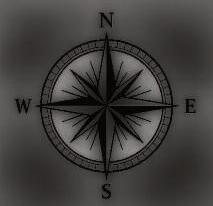
November 1st (All Saints' Day) November 11th (Armistice Day) December 25th and oen December 26th
Most shops are open from Monday to Saturday, from 10:00 am to 6:00 pm, althoug h those hours may var y from store to store Most shops are closed on Sundays, except Brussels at the Galler y St Hubert and g i shops near the Grand Place. In larg e cities such as Antwerp, Ghent and Brug es there are monthly Sunday shopping days, on which shops are usually open. Shops along the Flemish coast are also open on Sundays
Time Zone
Belg ium Time is located in the Central European Time Z one (CET ) 1 hour ahead of Greenwich Mean Time (GMT+1)
Belg ium’s countr y code is +32, so always dial 0032, followed by the area code and telephone number
e electric plug s in Belg ium mig ht be a bit different from those in your home countr y You may need an adaptor of the t ype AC.220 volts. Plug s are continental 2-pin round
People wi th disa bili ti es
Flanders is an accessible holiday destination for ever yone, that includes accommodation, transportation, museums and attractions. For more information oan travelling with a disabilit y, click here For free and tailored information, contact us at accessible@visitflanders com or +32 2 504 03 40.
Transp ortati on info
Flanders is the northern part of Belg ium It's mainly Dutchspeaking and fairly modest in size. To put thing s in perspective : it’s about the size of the state of Connecticut in the US or the count y of Yorkshire in the UK Because of its compactness, Flanders is an easy place to travel to, in and around
Brussels is Flanders’ capital and the beating heart of Europe It has countless flig ht and train connections. London, Paris, Amsterdam and Berlin are only a short distance away Similarly, all of Flanders' cities are within reach of each other and easily accessible by public transport or car.
By a ir
Brussels Airport is Belg ium's main international airport Frequent train connections from the airport will take you to Brussels in 20 minutes and
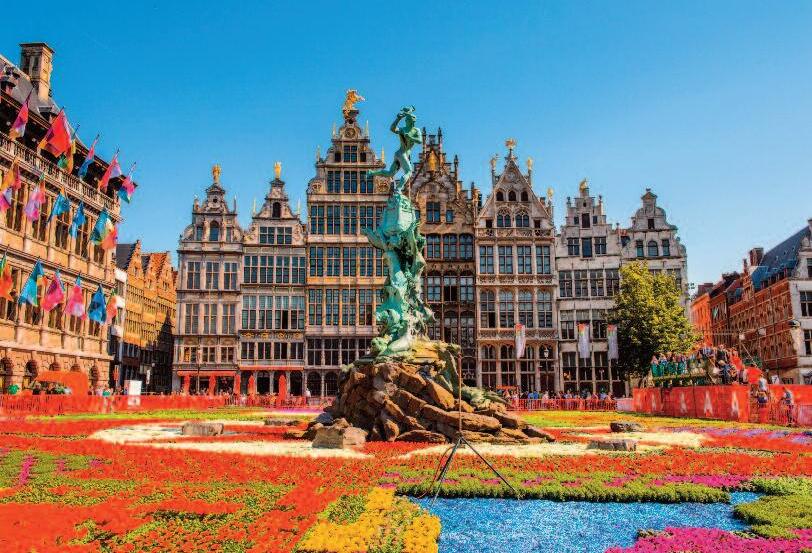
to Antwerp in 35 ere are plent y of bus lines too, which run from 5 a .m. until midnig ht, from Monday to Saturday. On Sundays, the first bus departs at 7 a .m.. Ta xis are available 24/7 at Brussels Airport. e y will take you to Brussels’ cit y centre for an averag e price of 45 euros.
Brussels Airport
Althoug h located in Wallonia , the French speaking part of Belg ium, Brussels South
Charleroi Airport is a popular point of arrival when visiting Flanders. Brussels South is 37.28 miles (60 km) away from Brussels A direct bus will take you from the airport to the Charleroi-South railway station
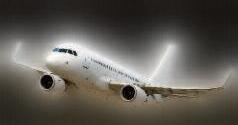
in 20 minutes From there, there are plent y of direct
connections to Flanders’ larg est cities, as well as direct shuttle buses to Ghent and Brug es.
Brusse ls South Charleroi Airp or t
By tra in
Flanders is easily accessible by international trains from London, Paris and Amsterdam, among other places. e Eurostar will take you from the Brussels South Station to
London in less than 2 hours. e alys connects that same railway station with Paris (1h25) and Amsterdam (1h52). Reser ve your seats in advance at B -Europe or R ail Europe.
By c oa ch
If you ’ re planning a group trip by coach, keep in mind that most art cities don't allow coaches or larg e private buses in the cit y centre In that case, coaches must park in designated spots. More information on coaches in Antwerp, Brug es, Brussels, Ghent, Leuven and Mechelen.
Travelling in Flanders
By train, bus, tram and metro By train, it oen takes less than an hour to travel between two major cities in Flanders. Find out more at Belg ian R ail

